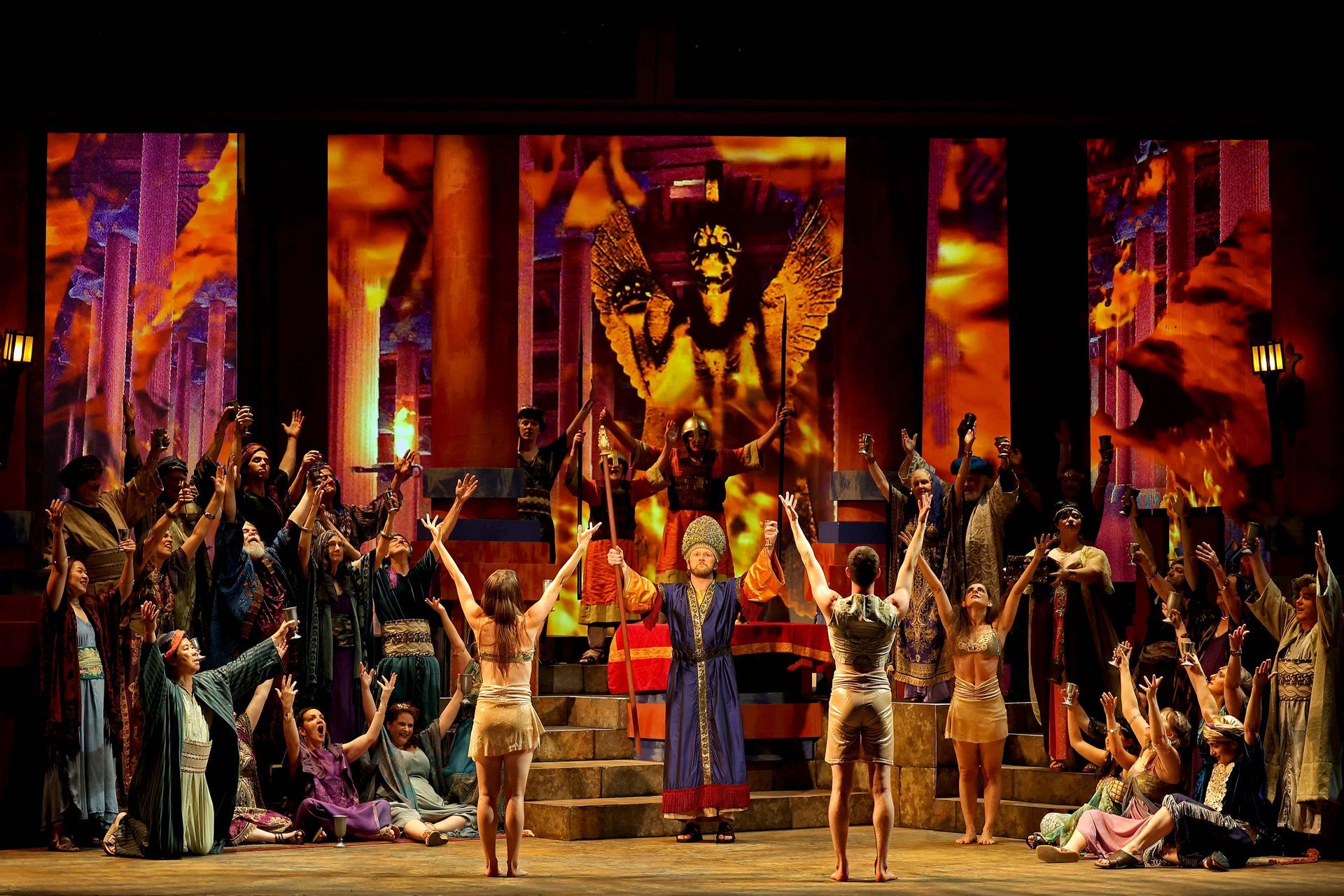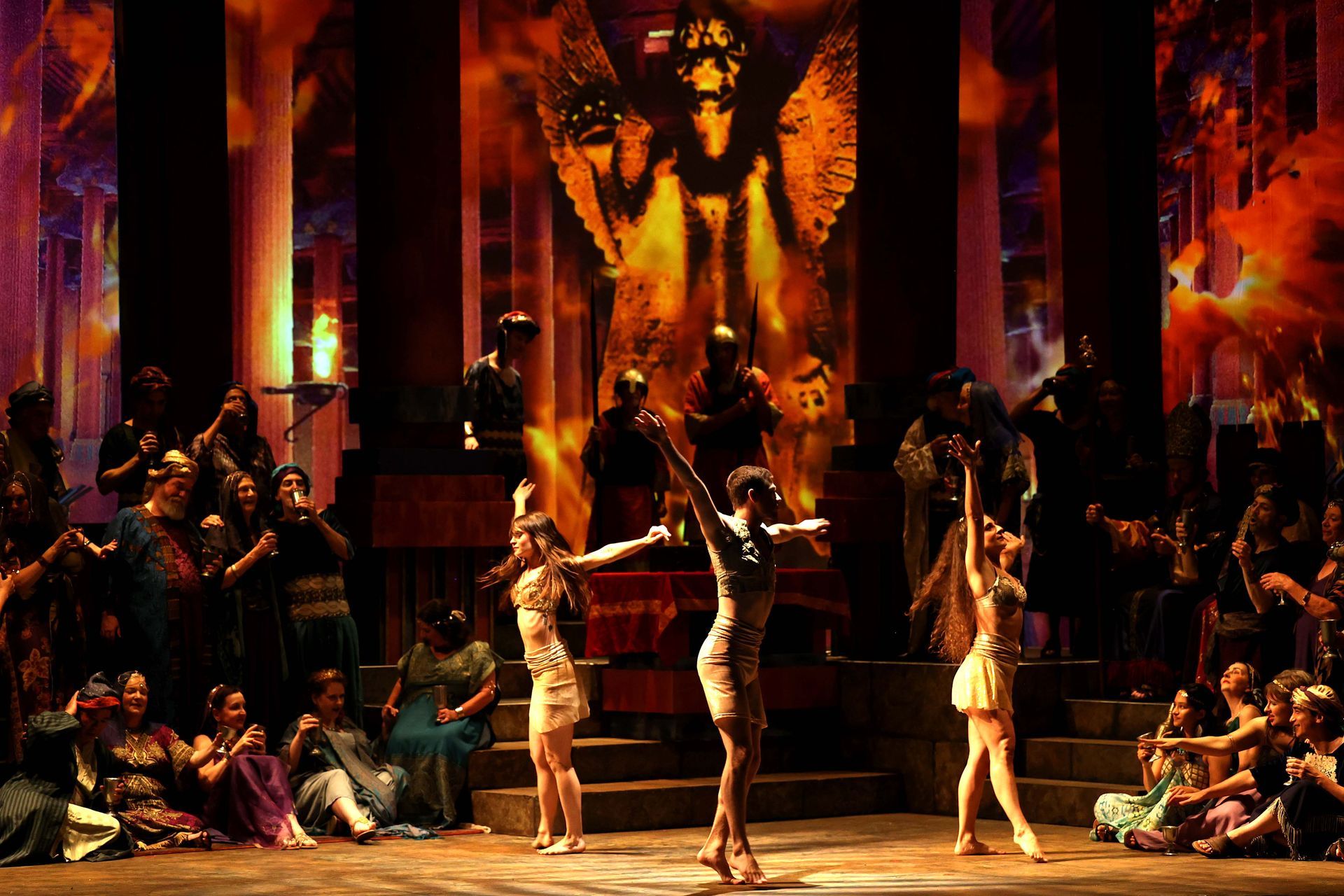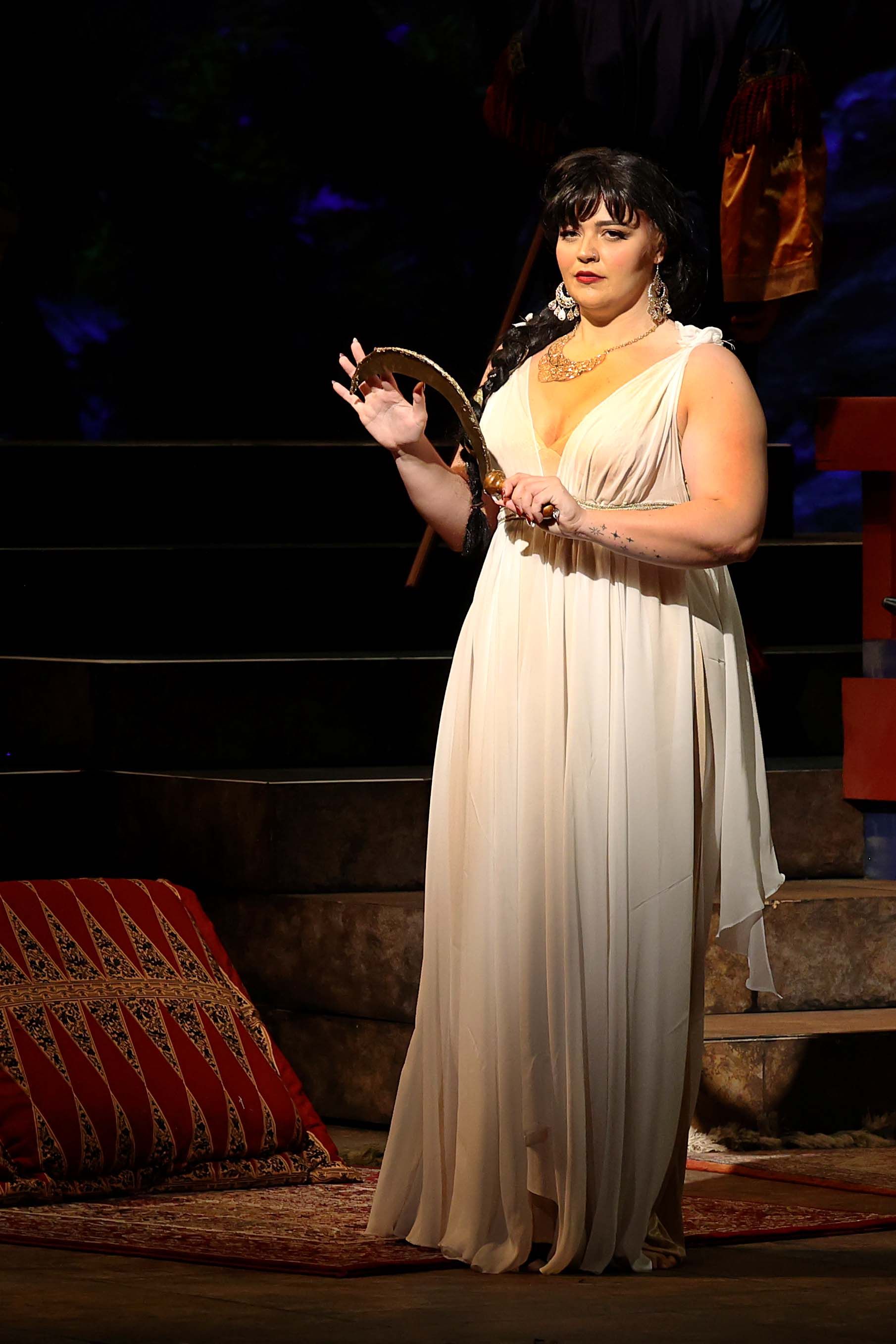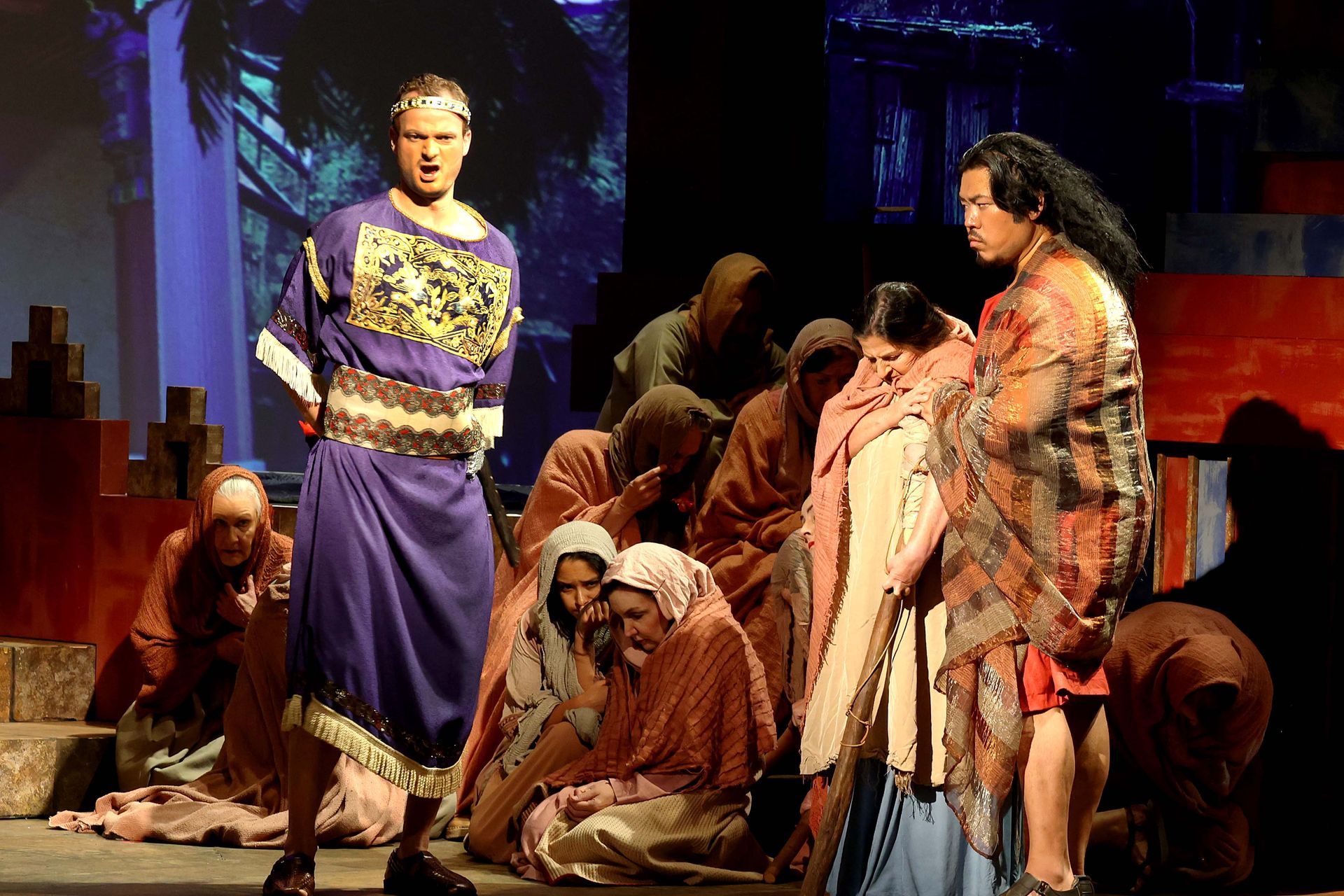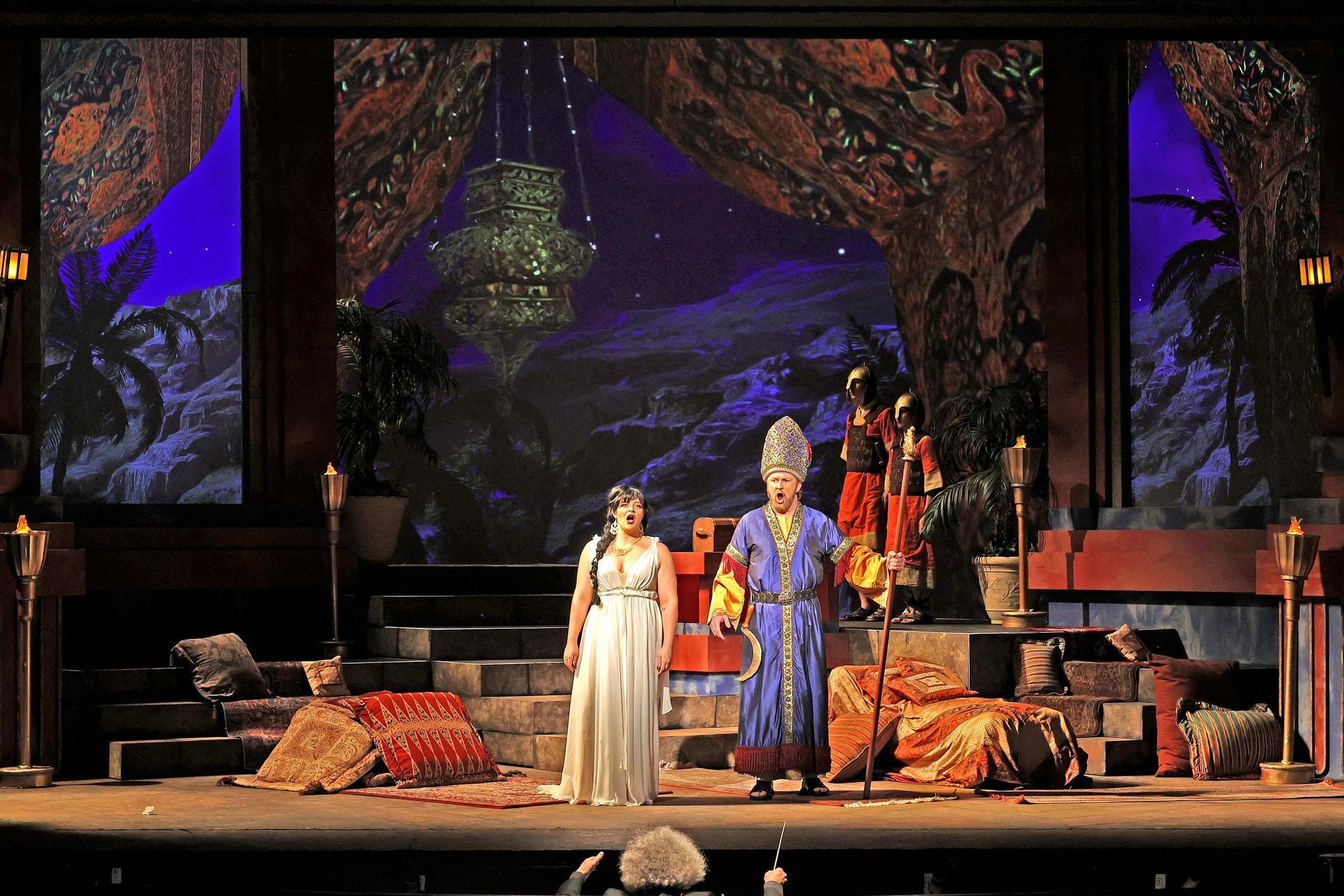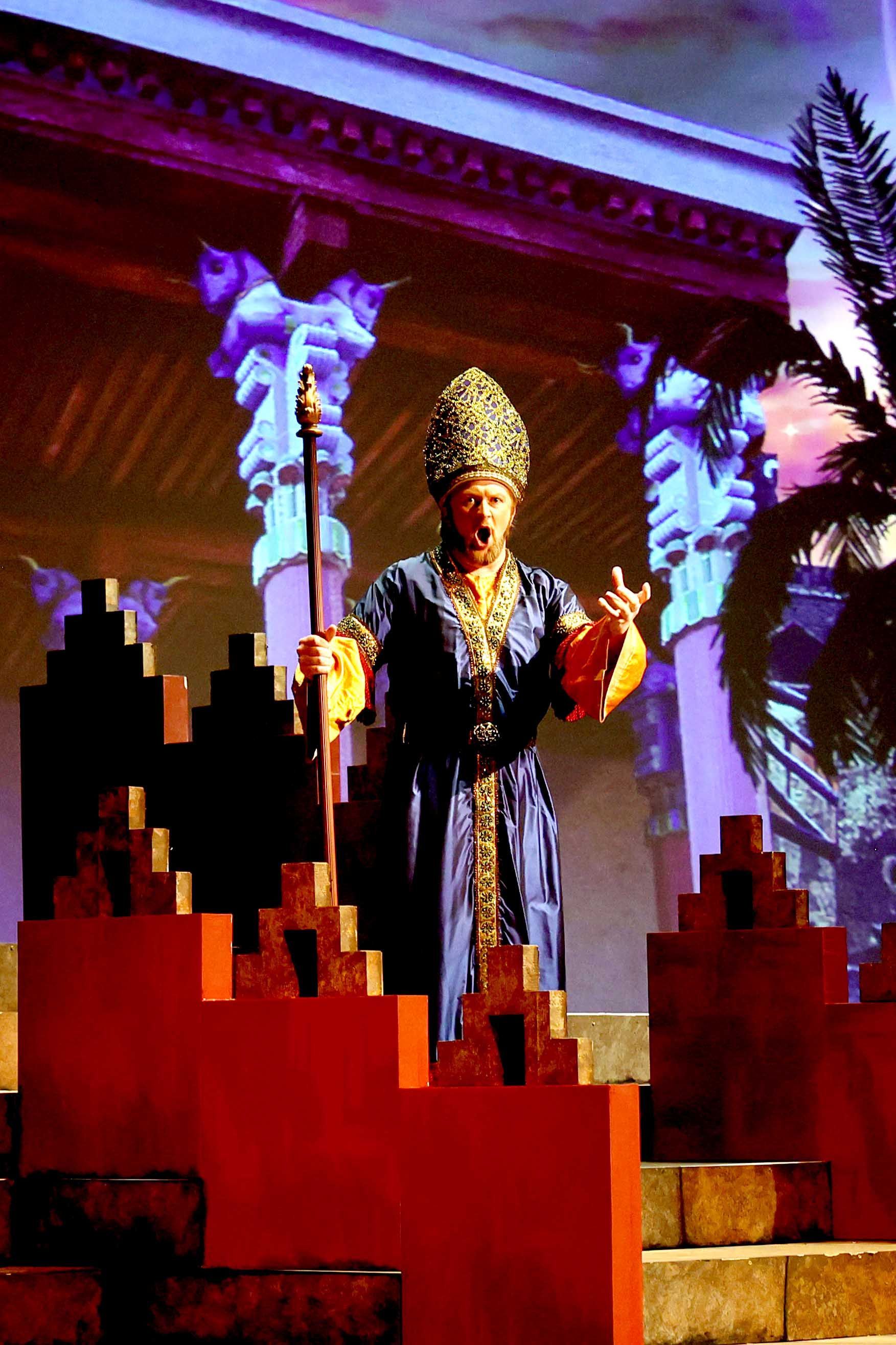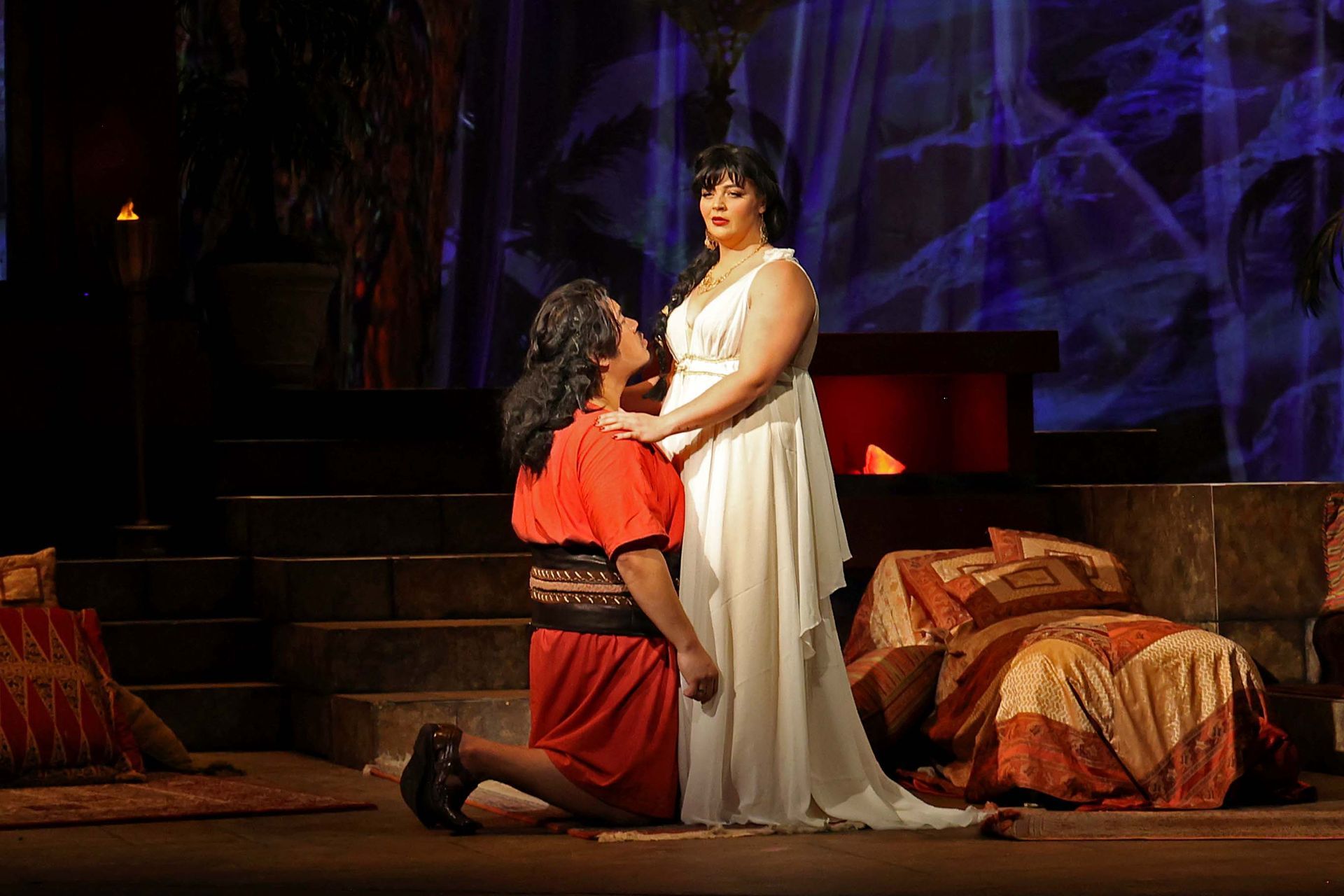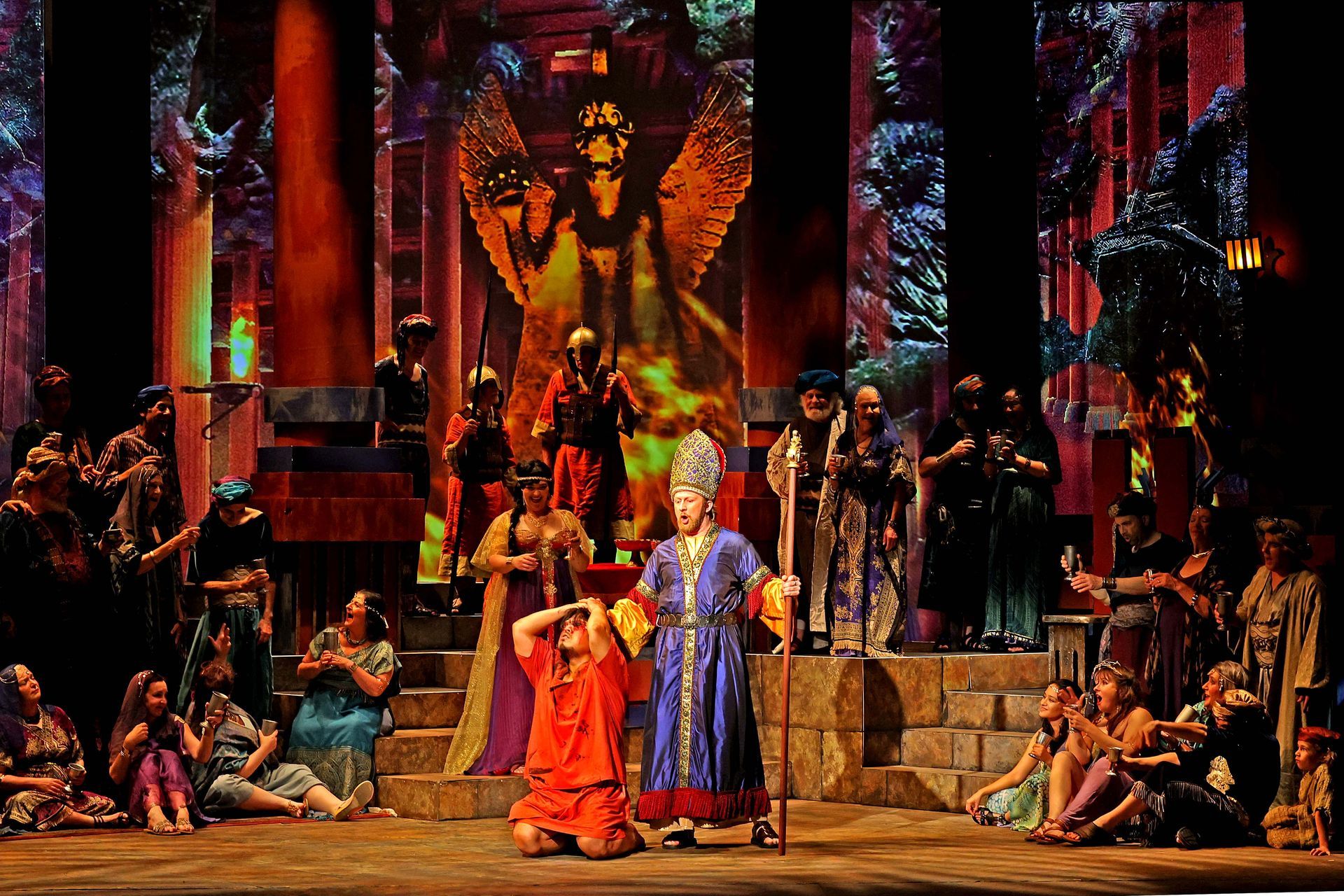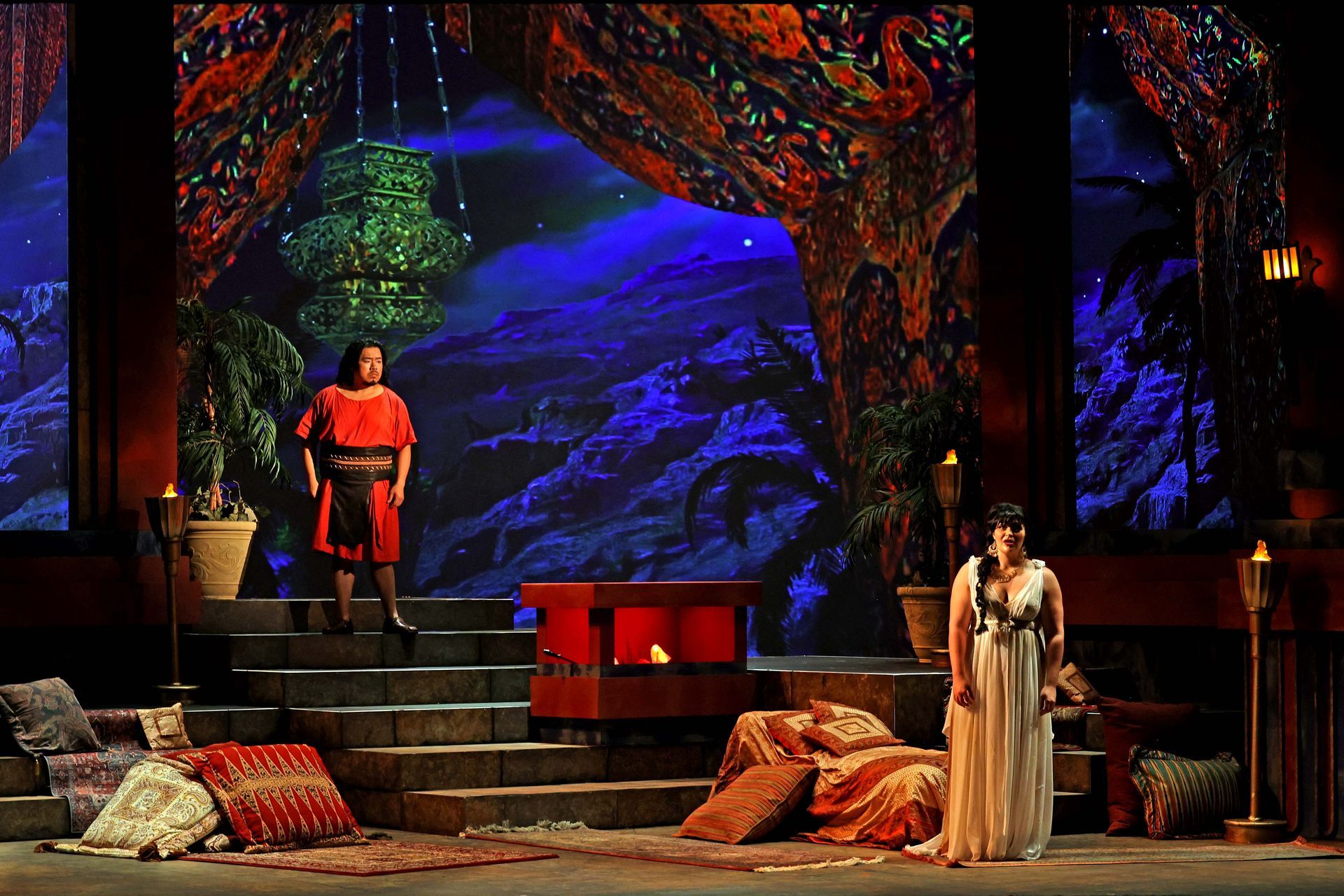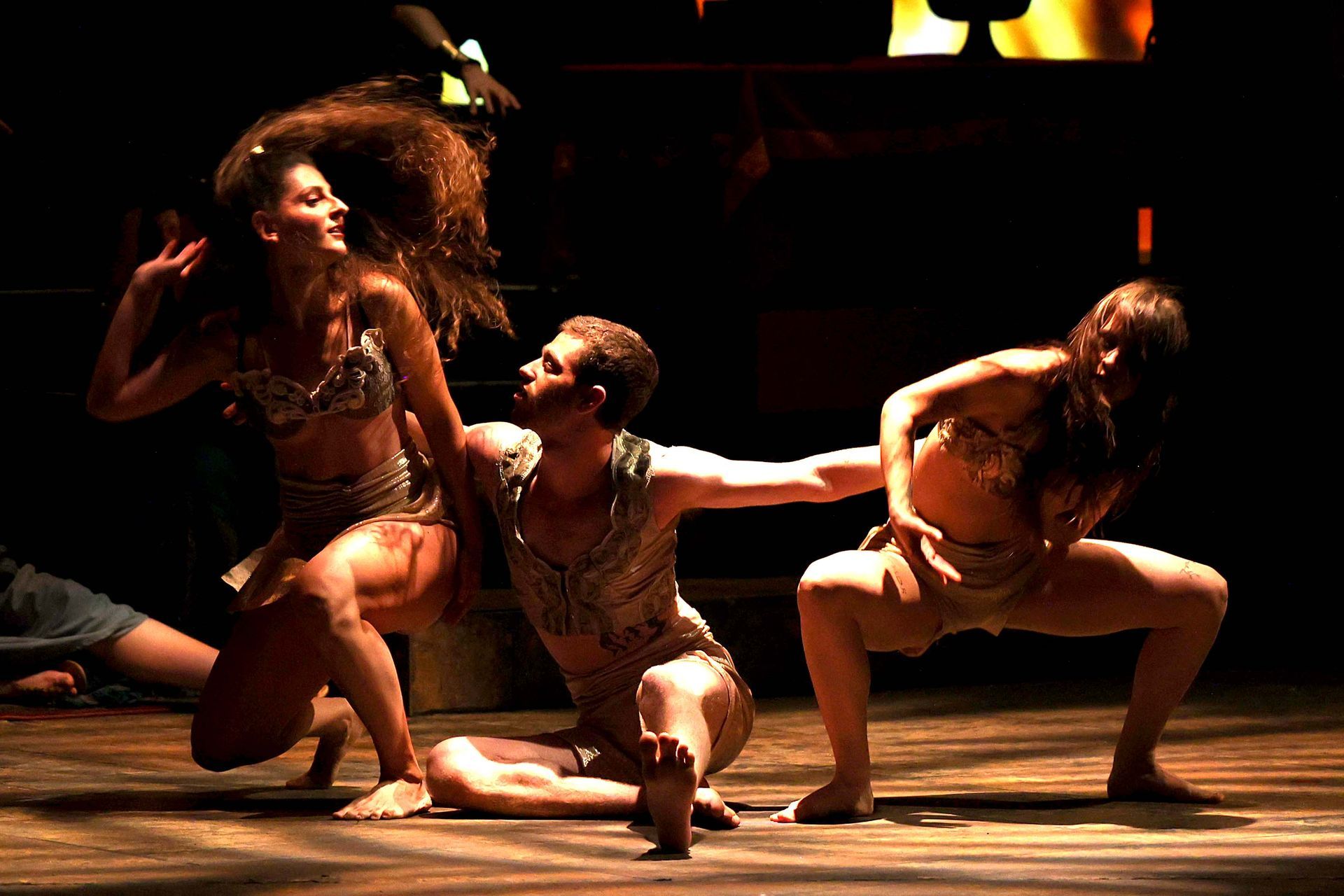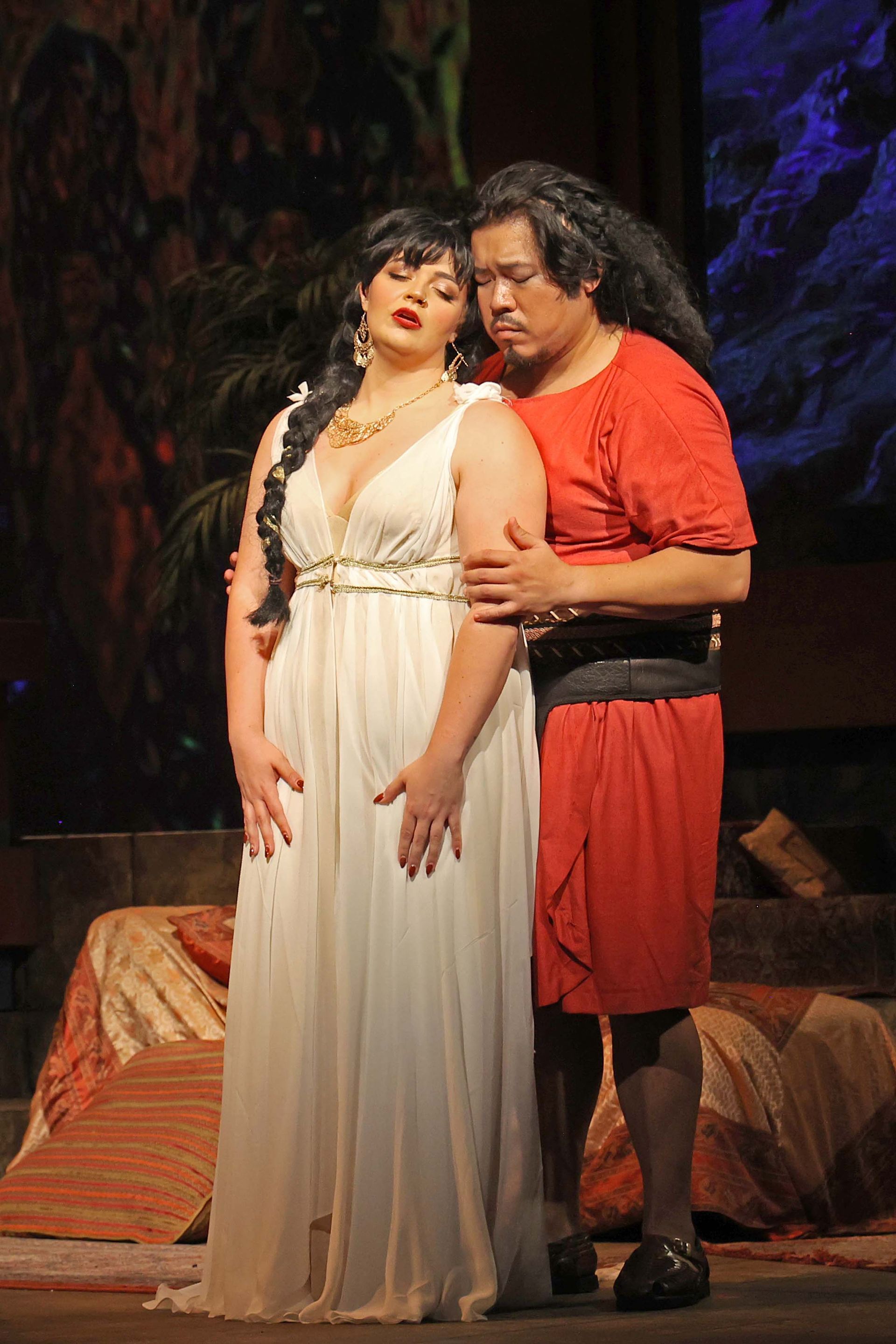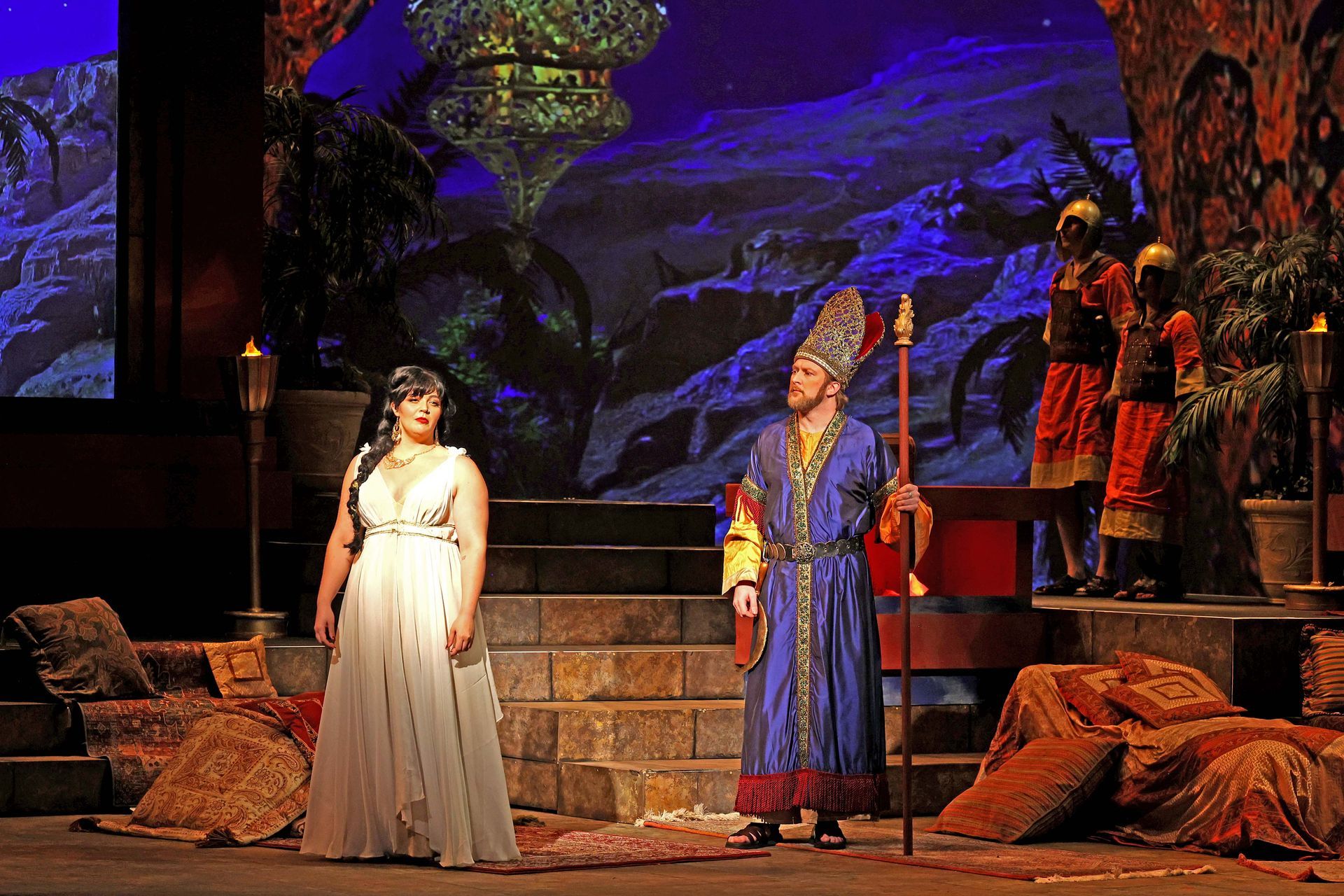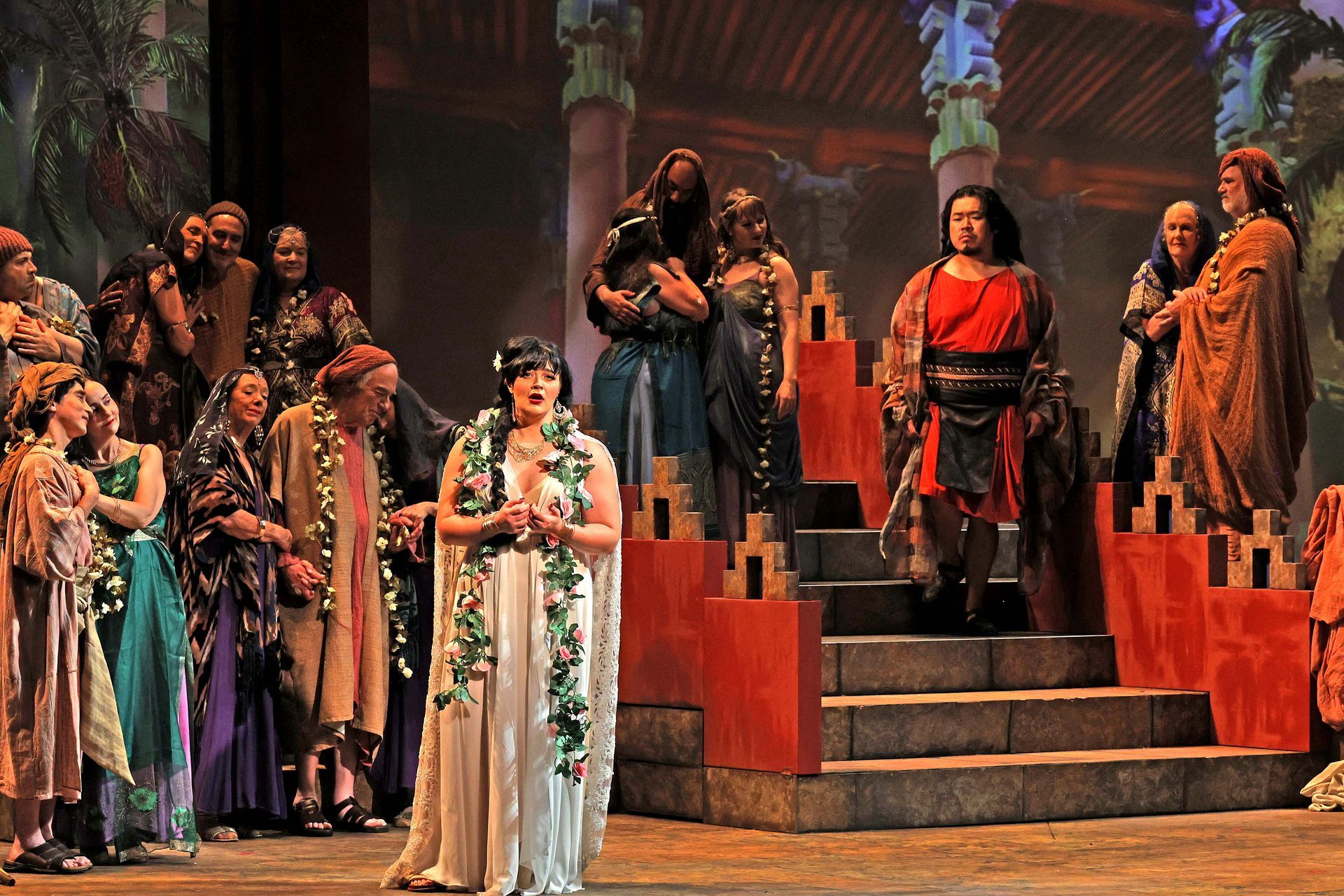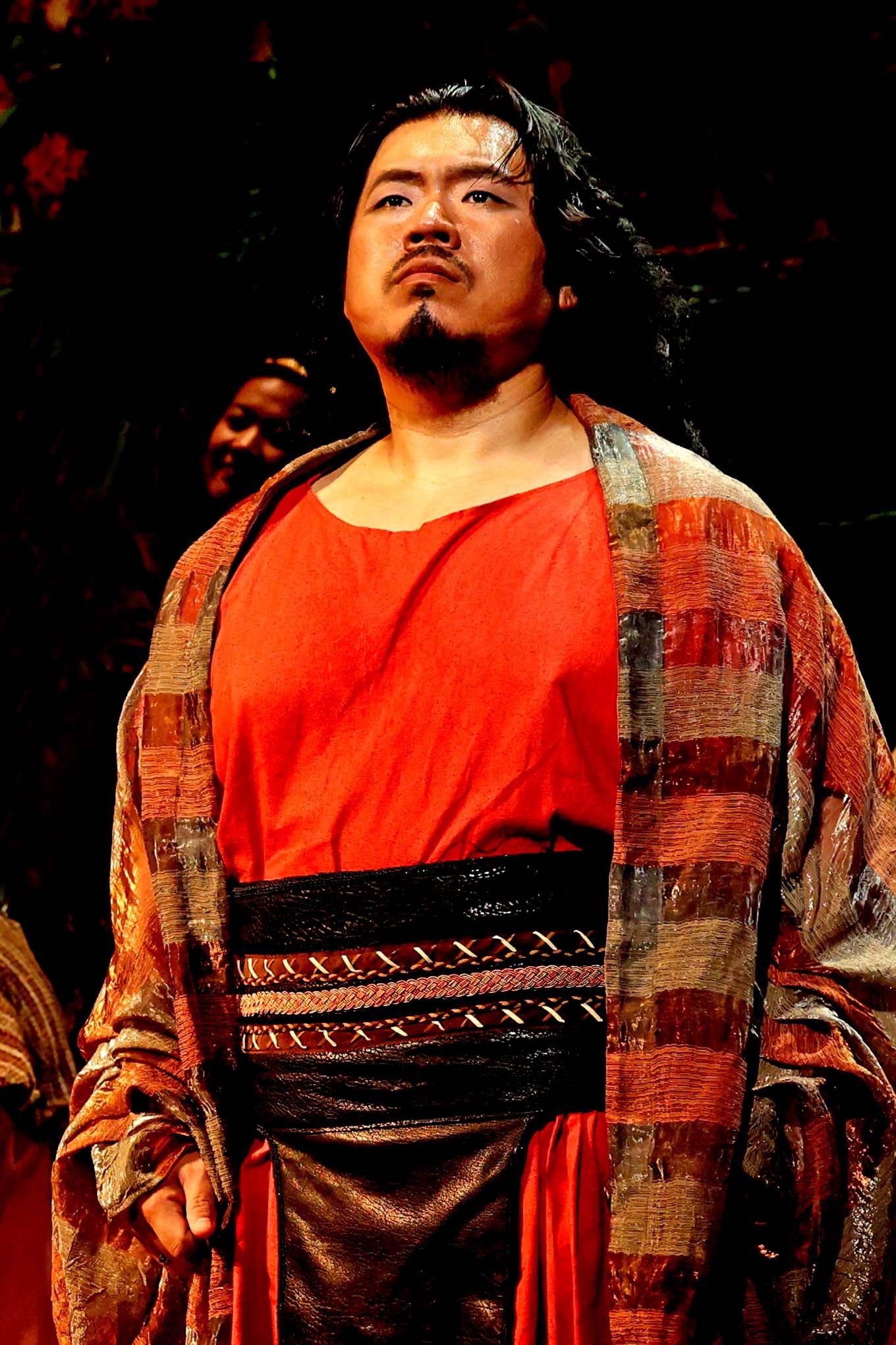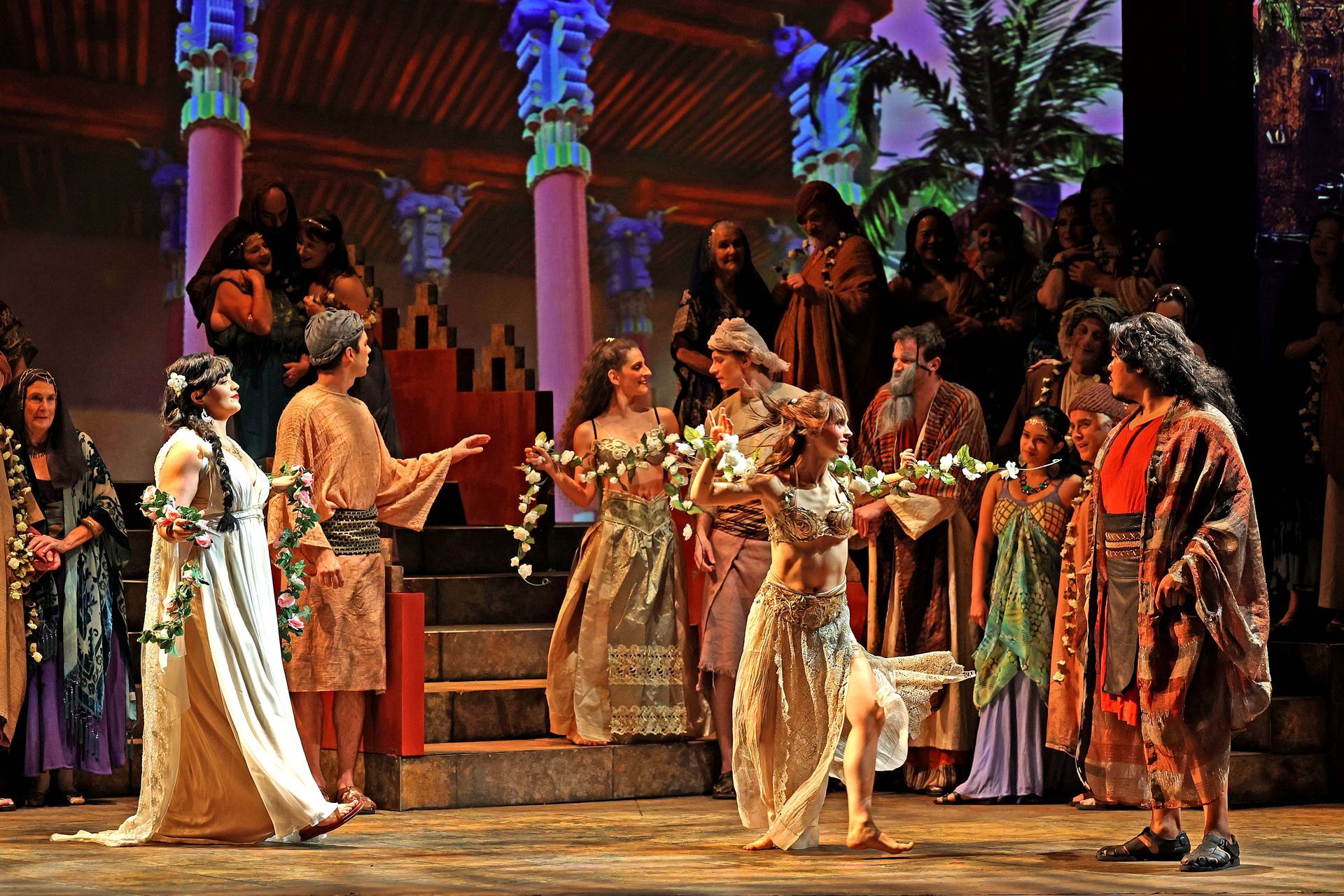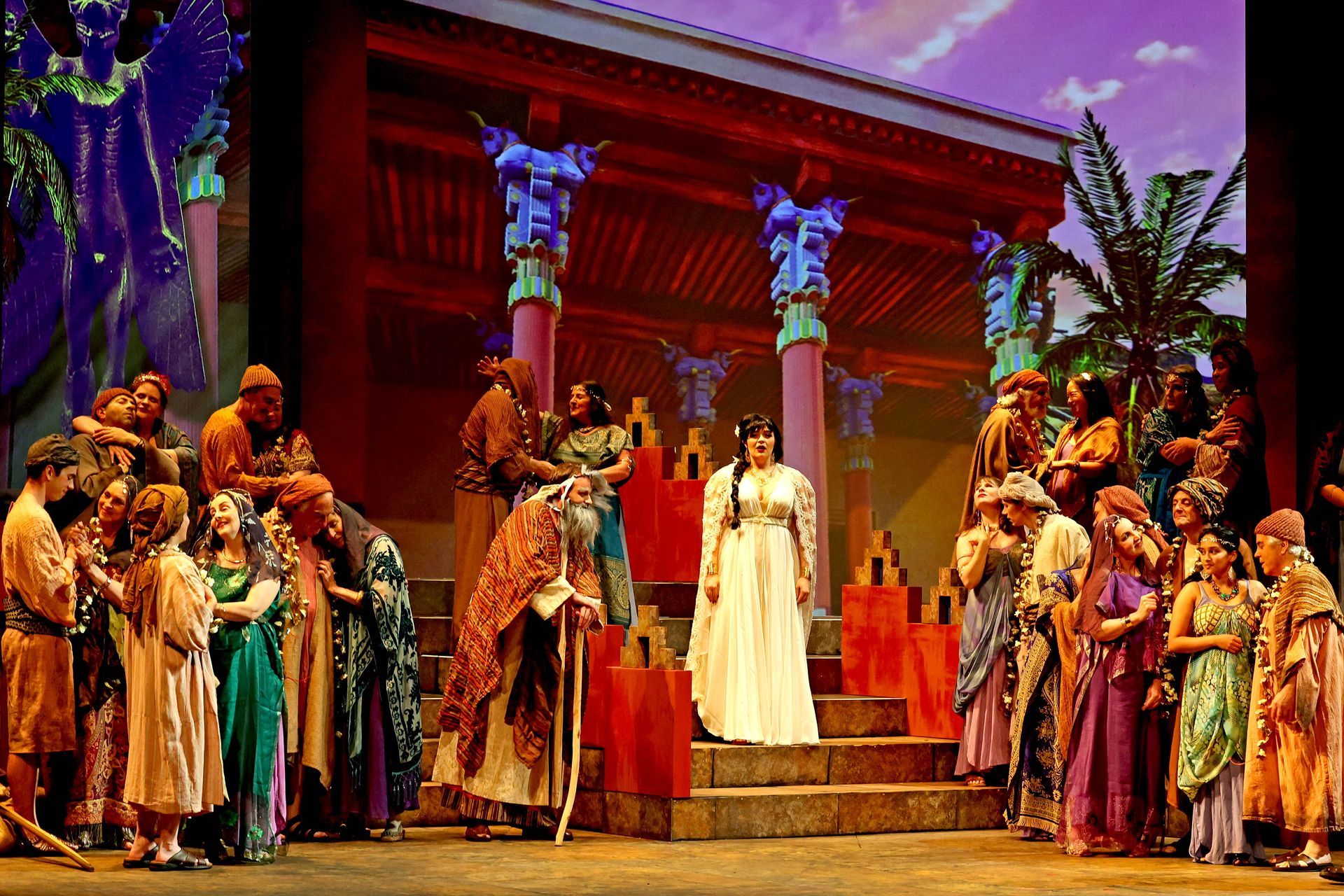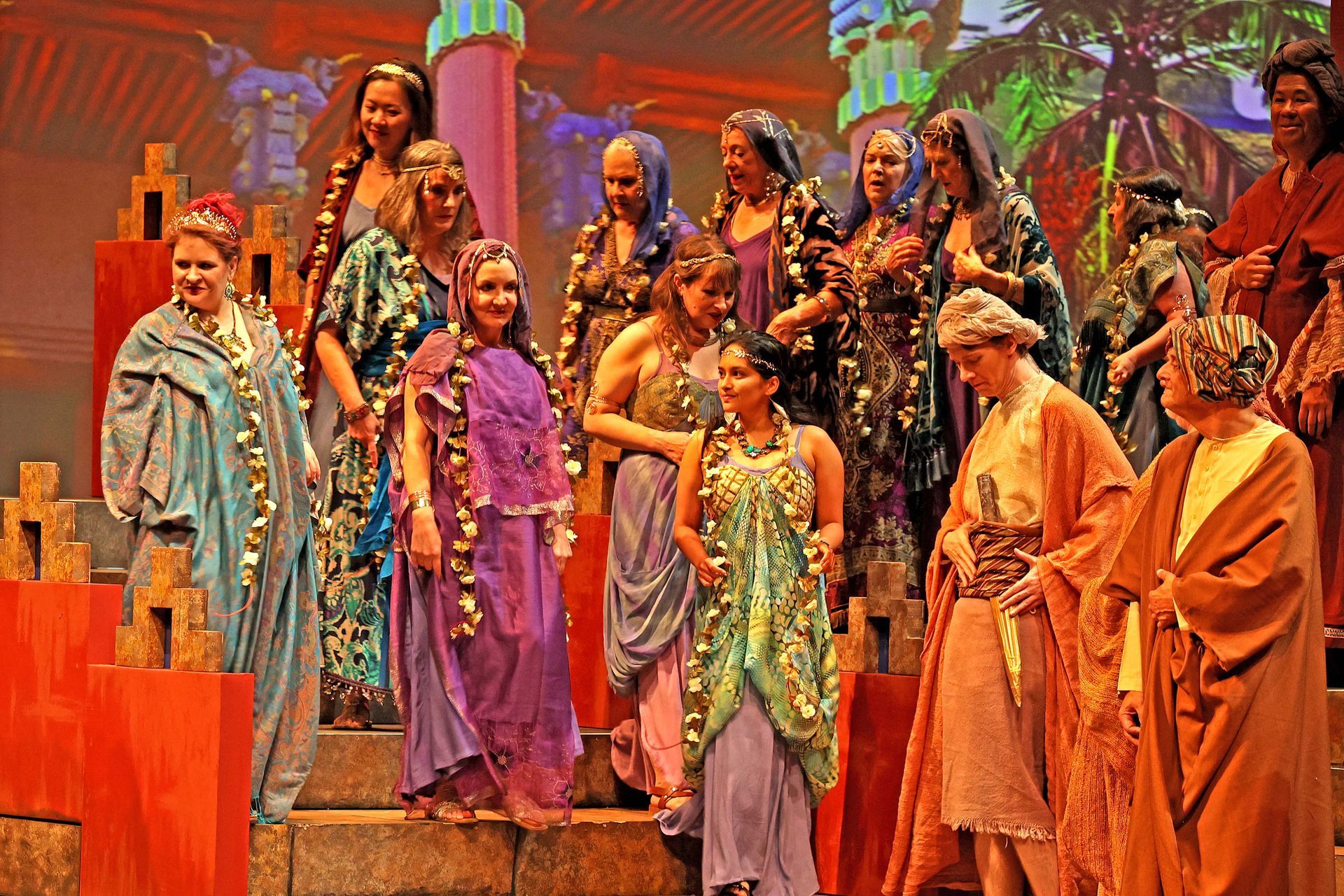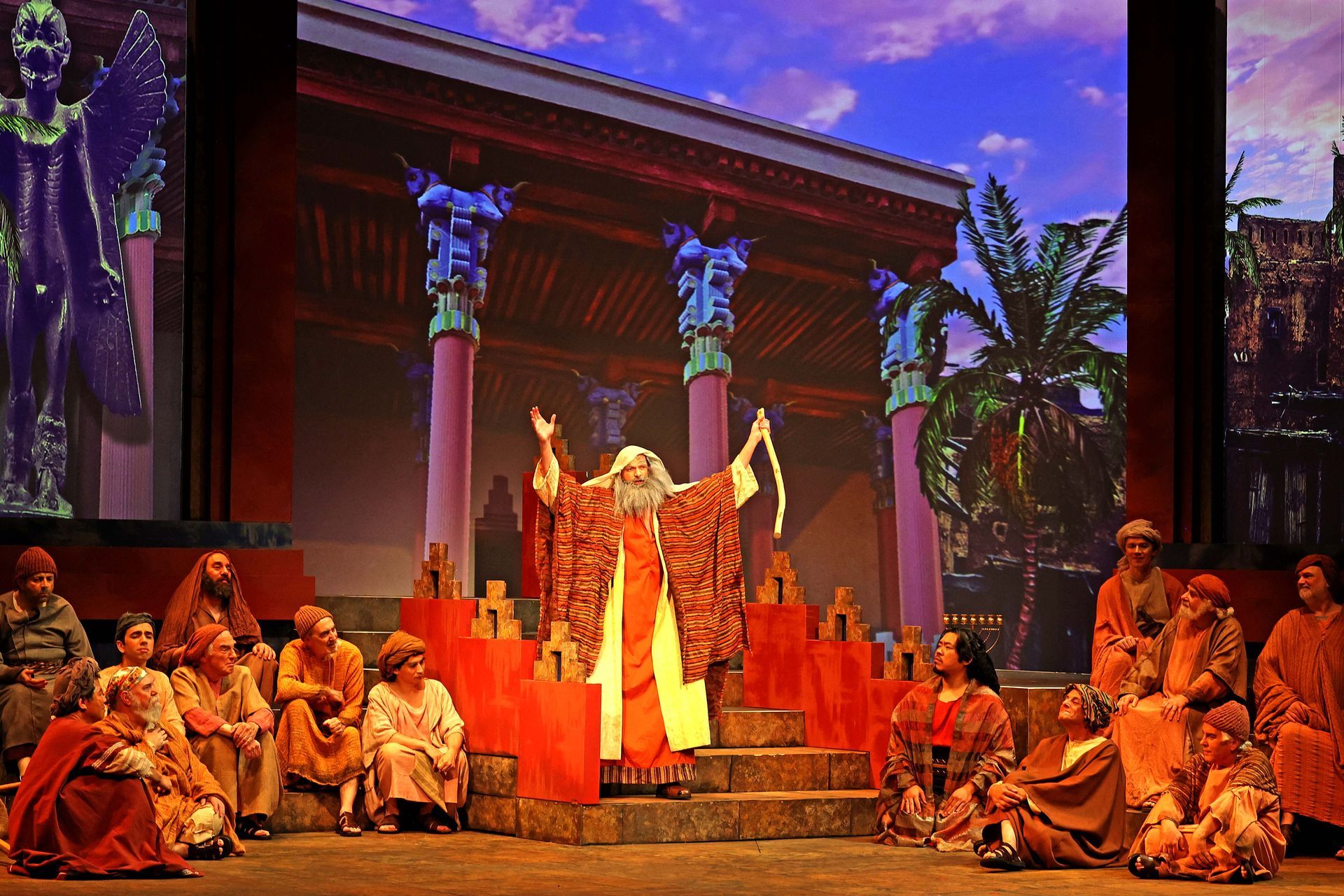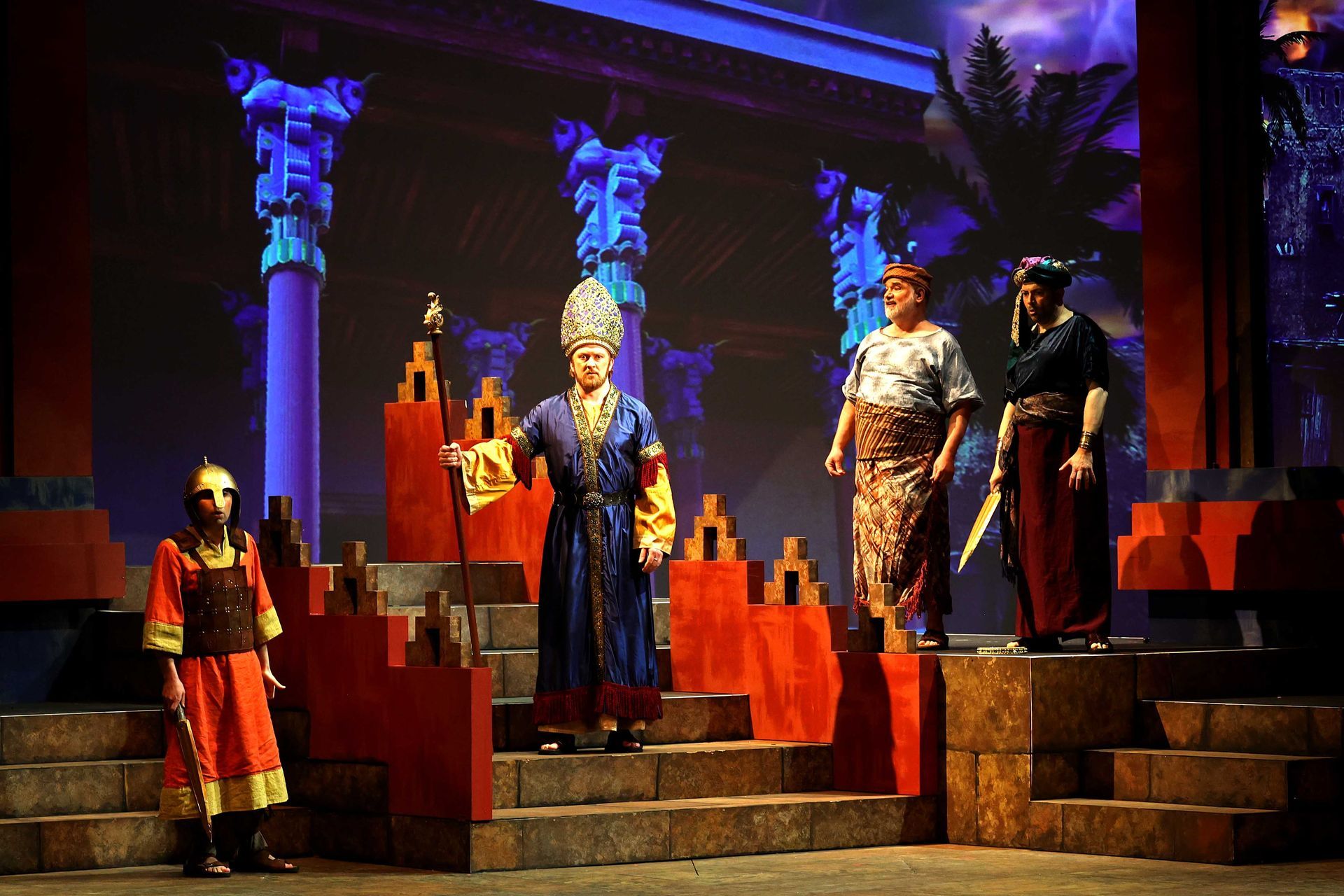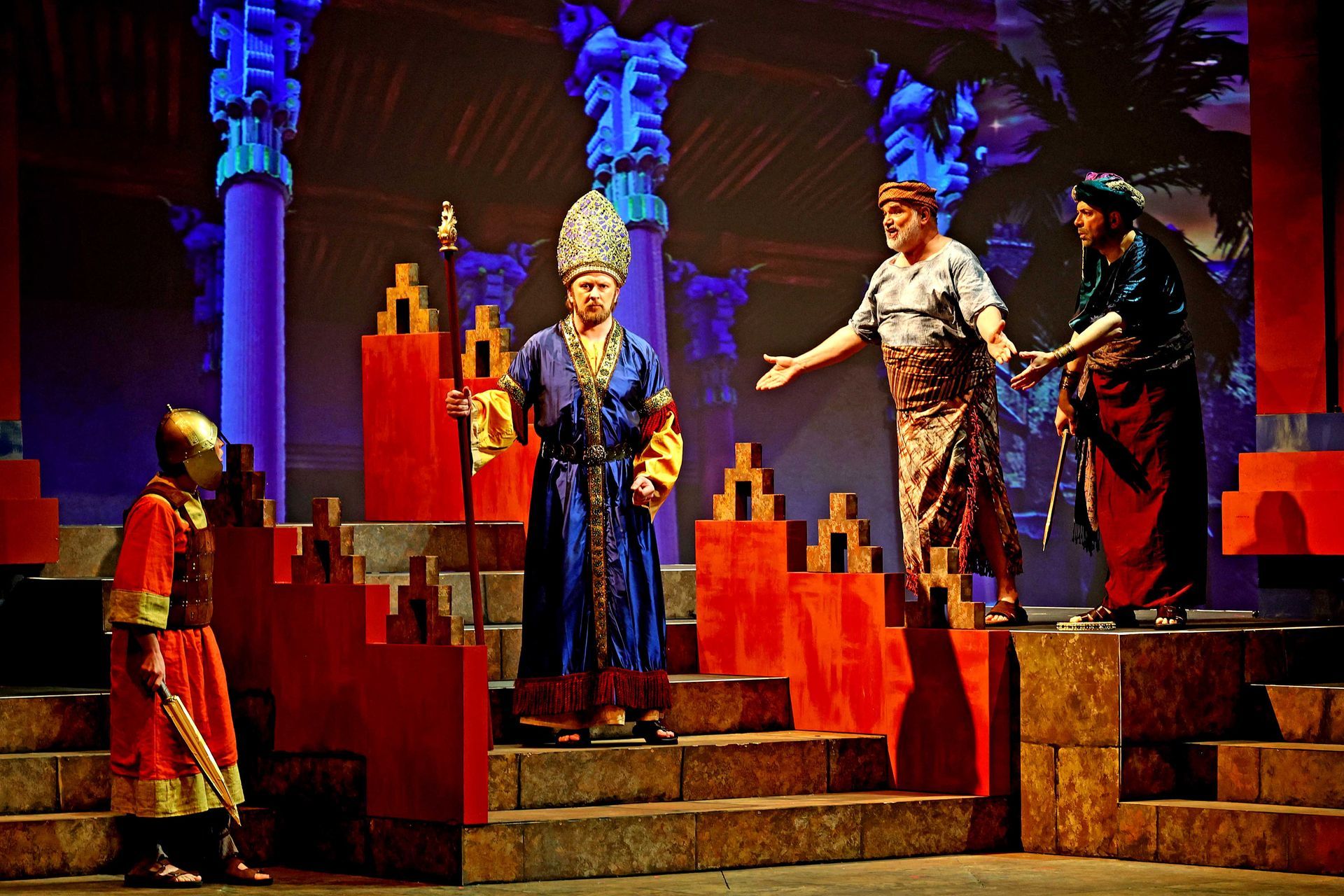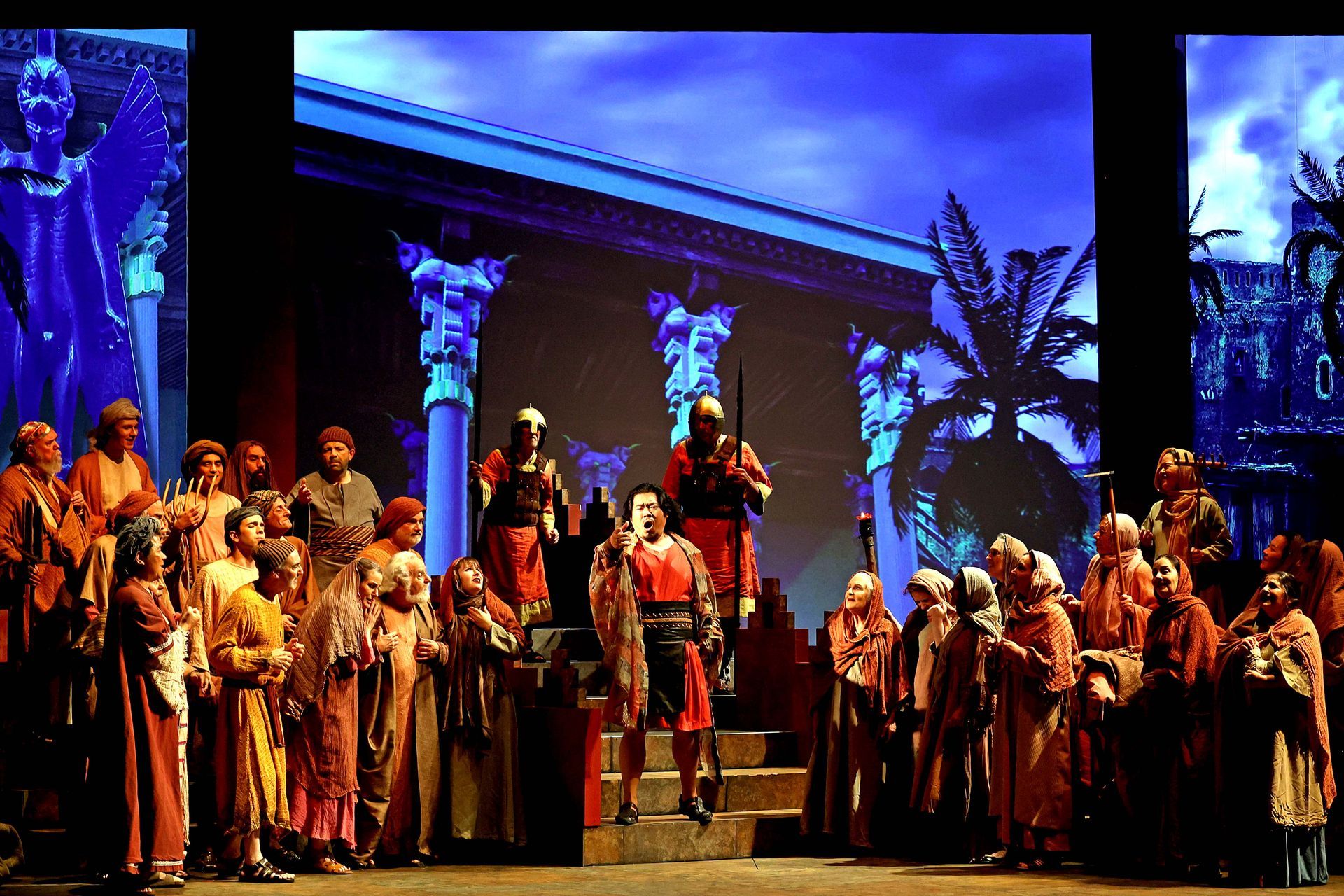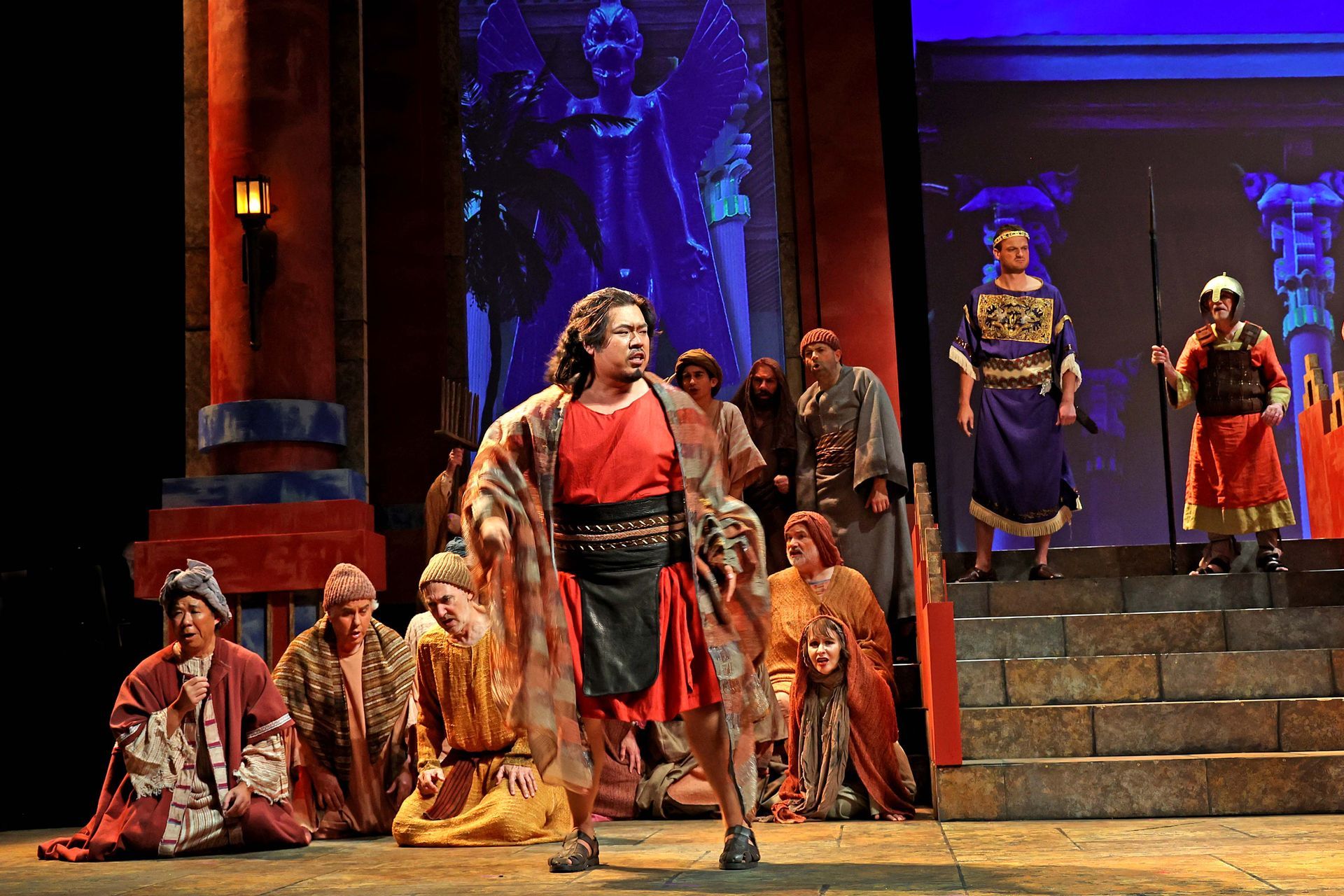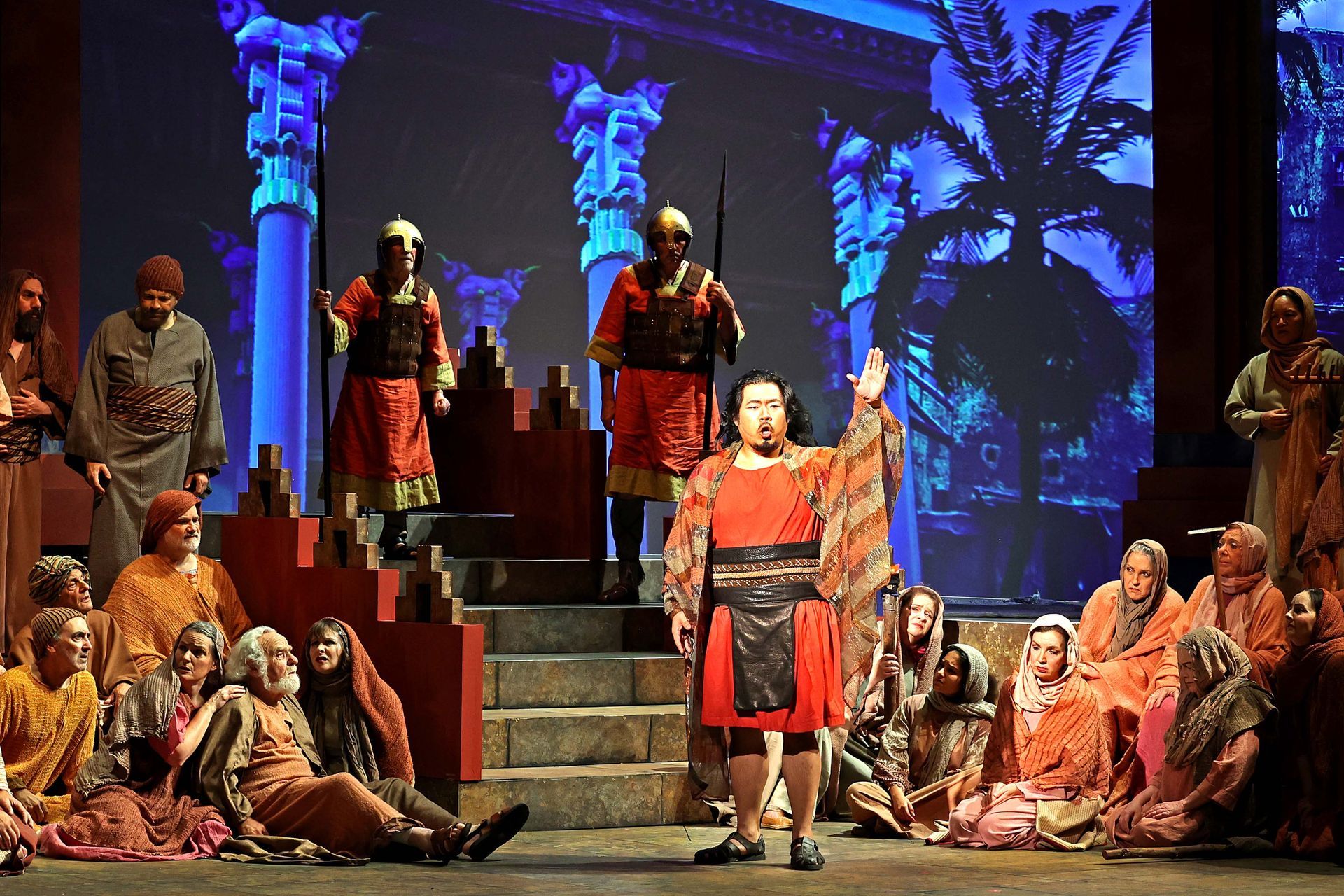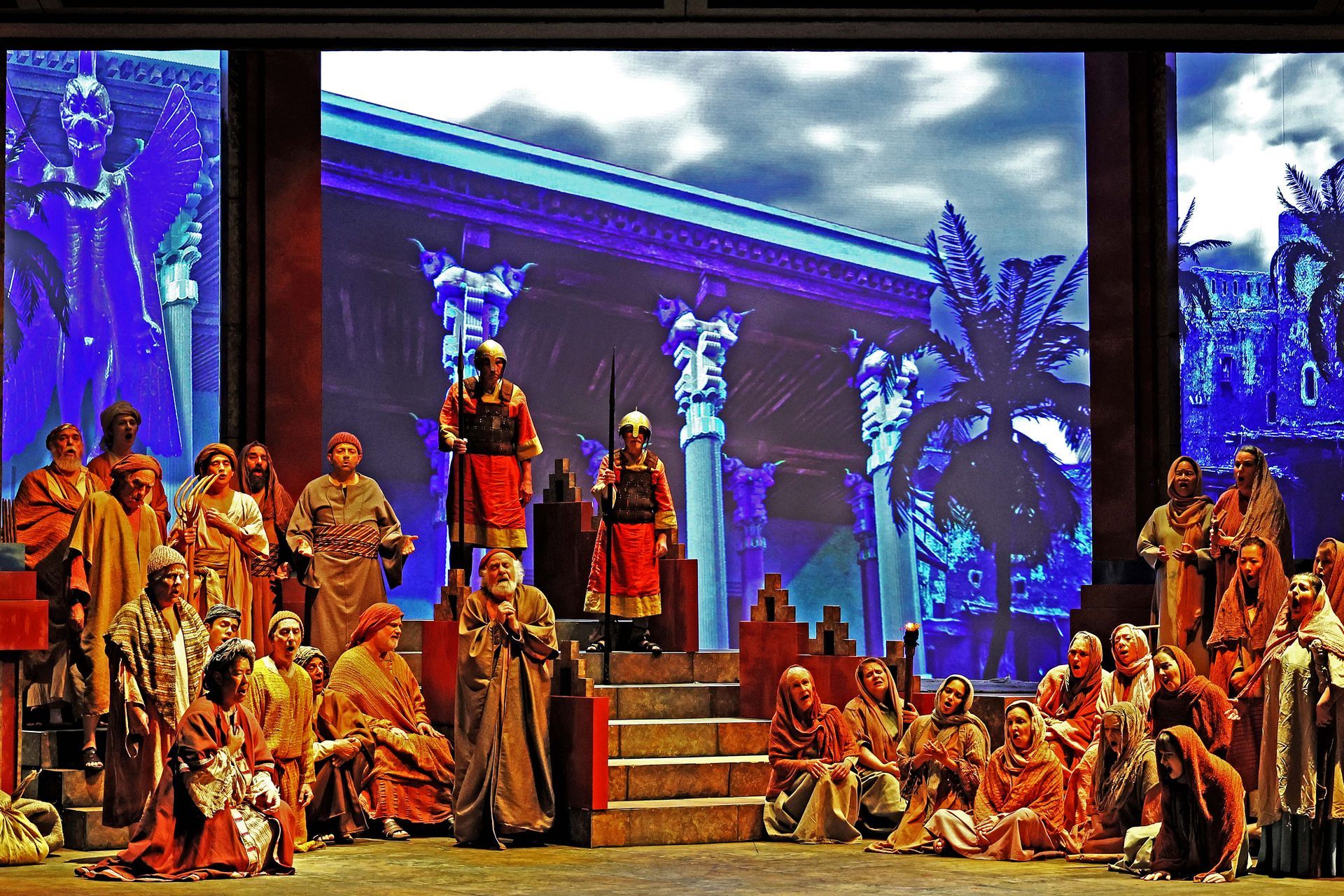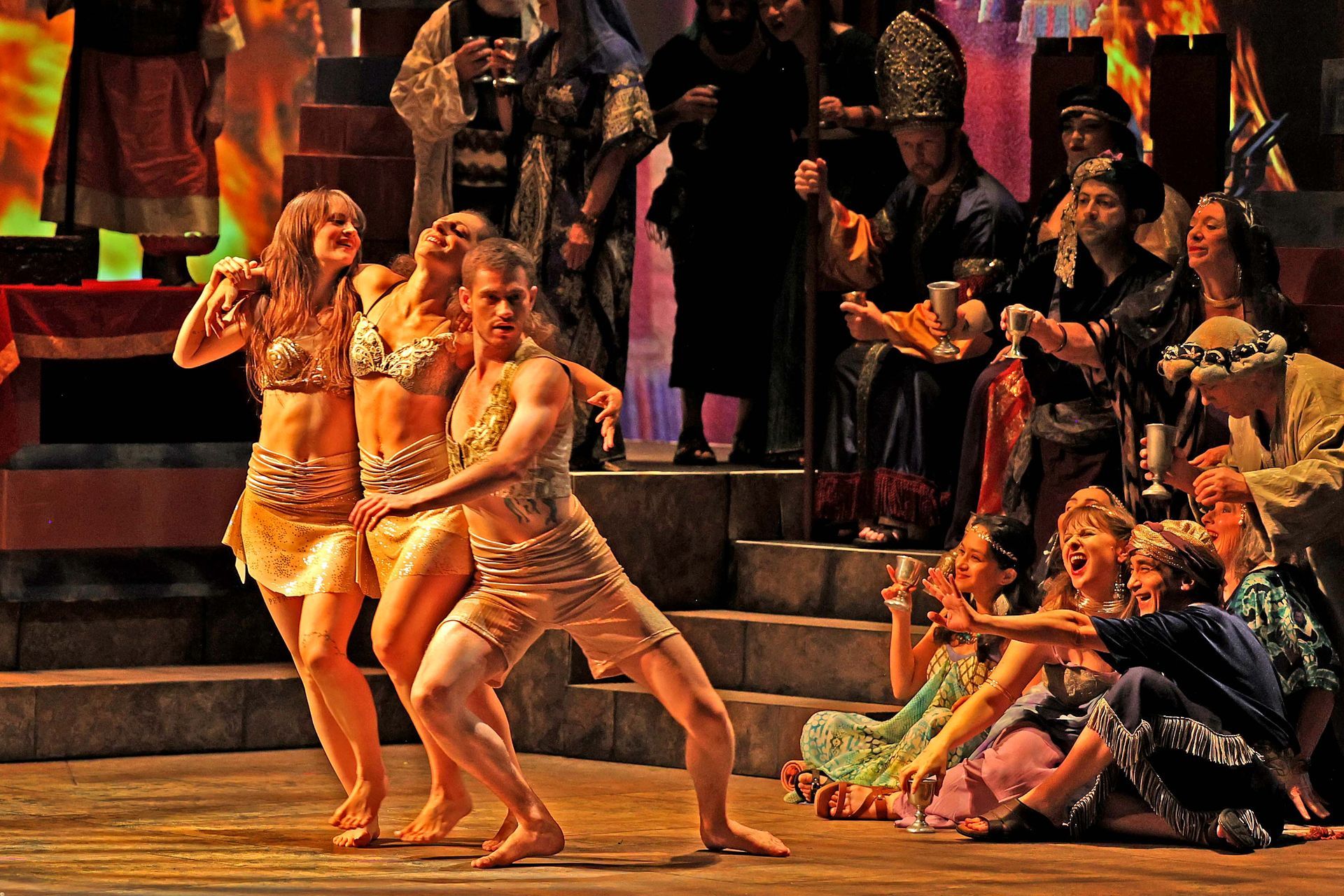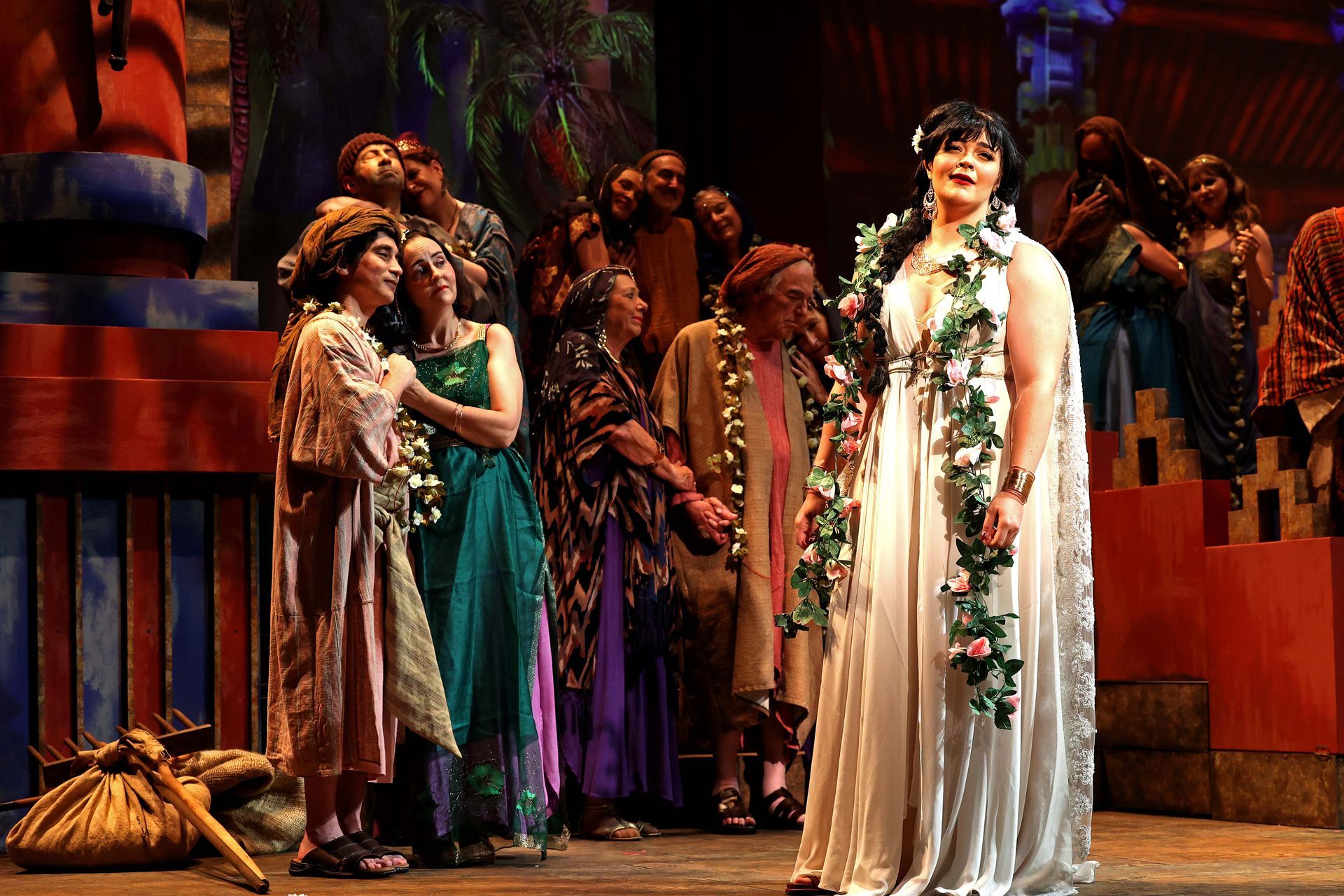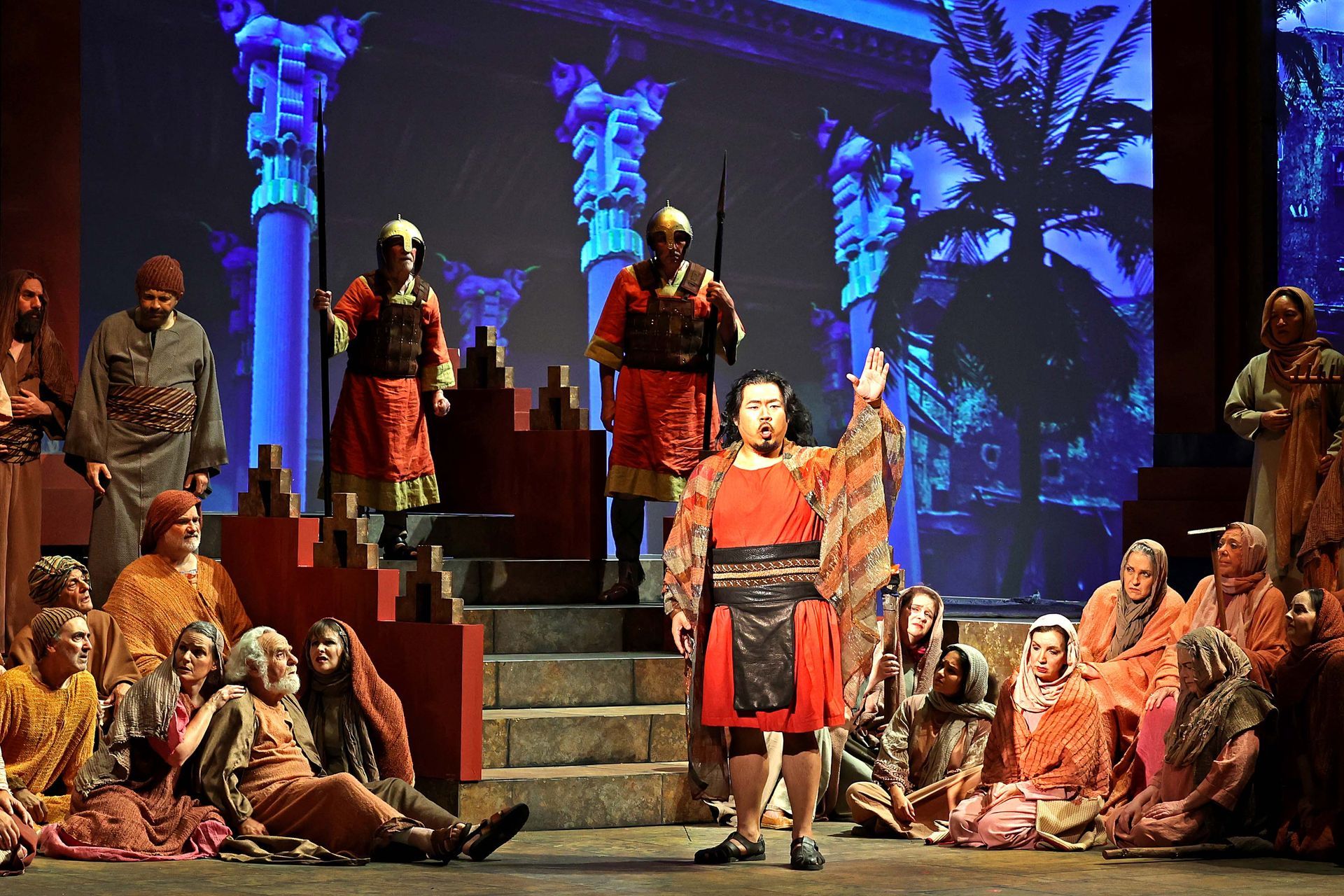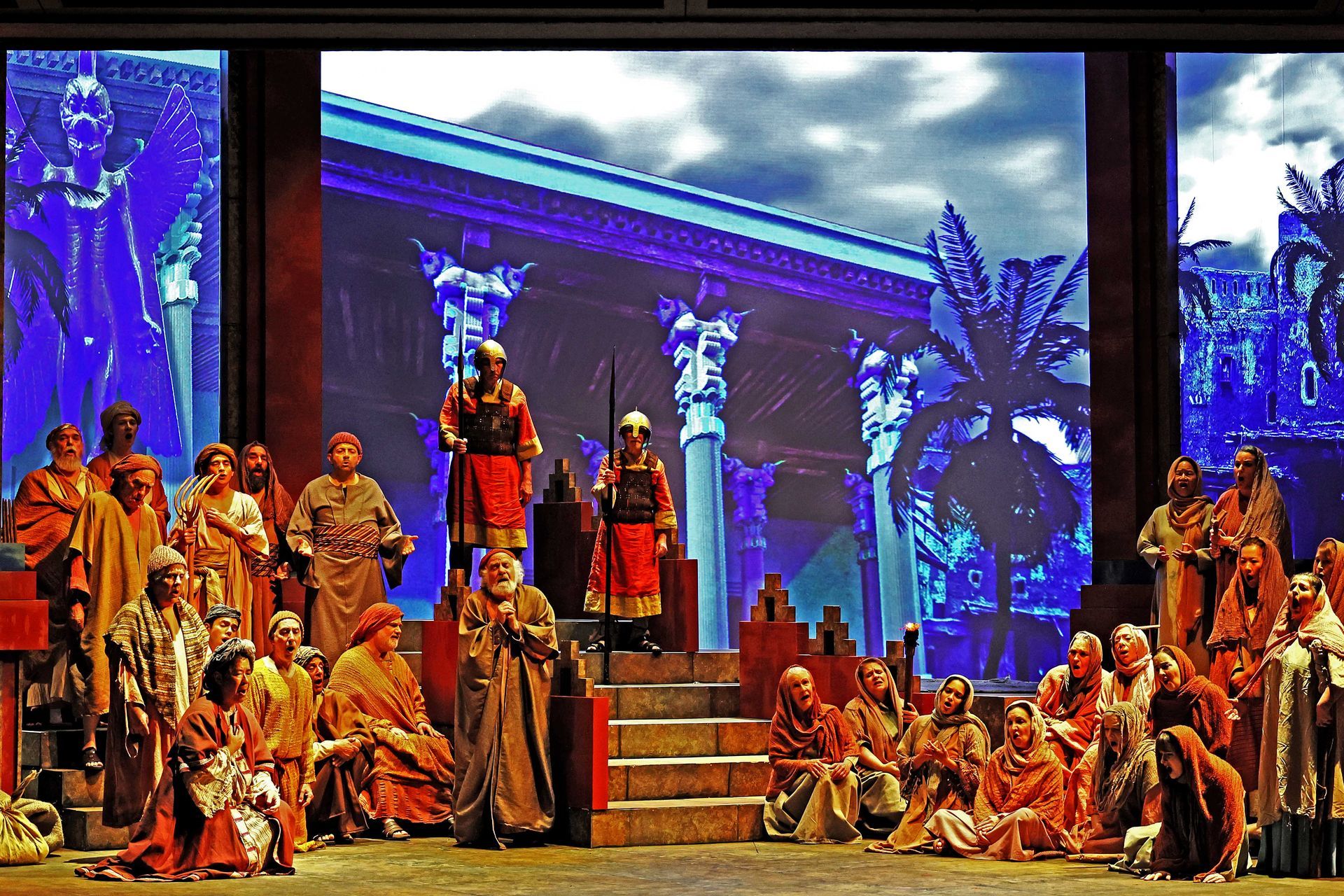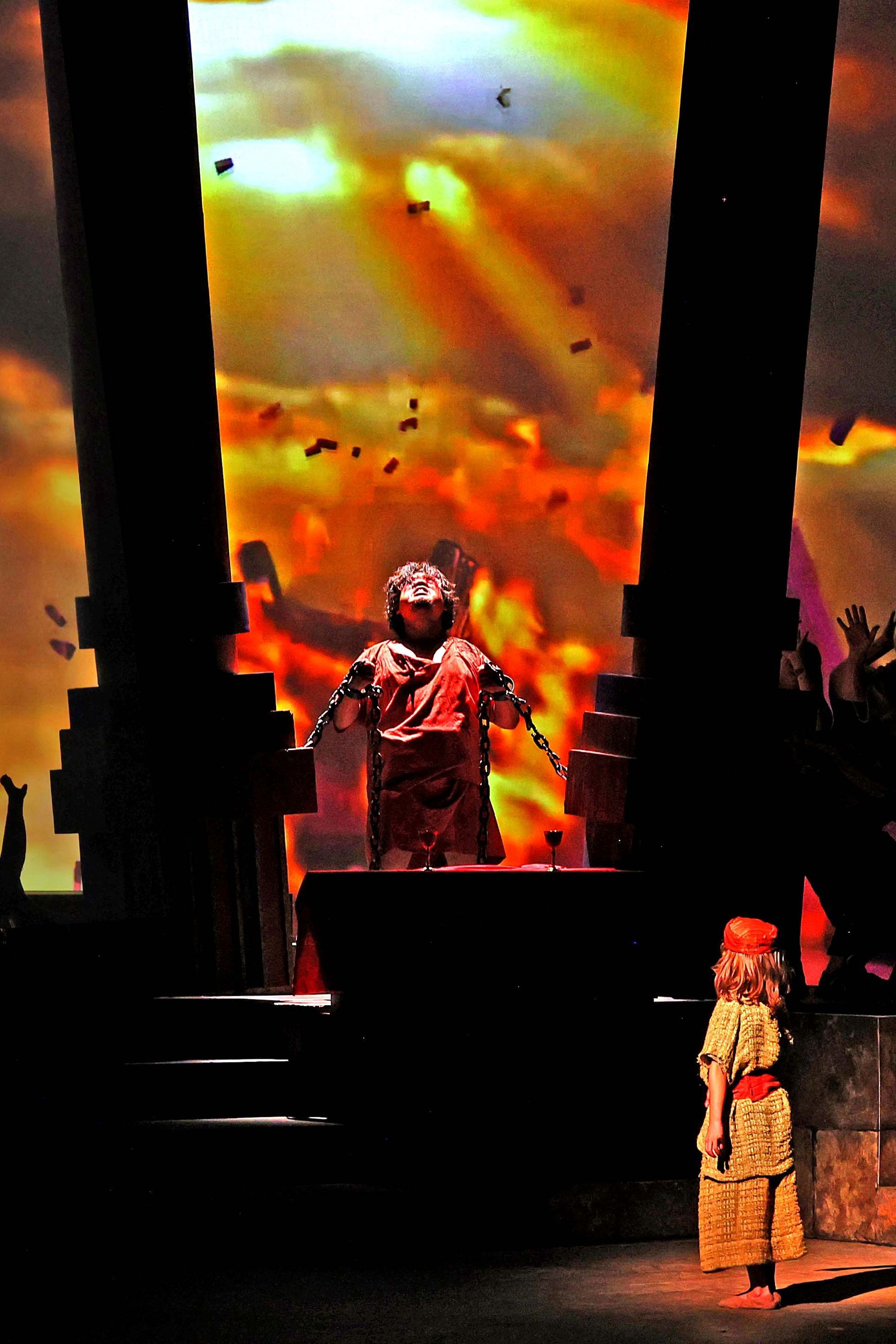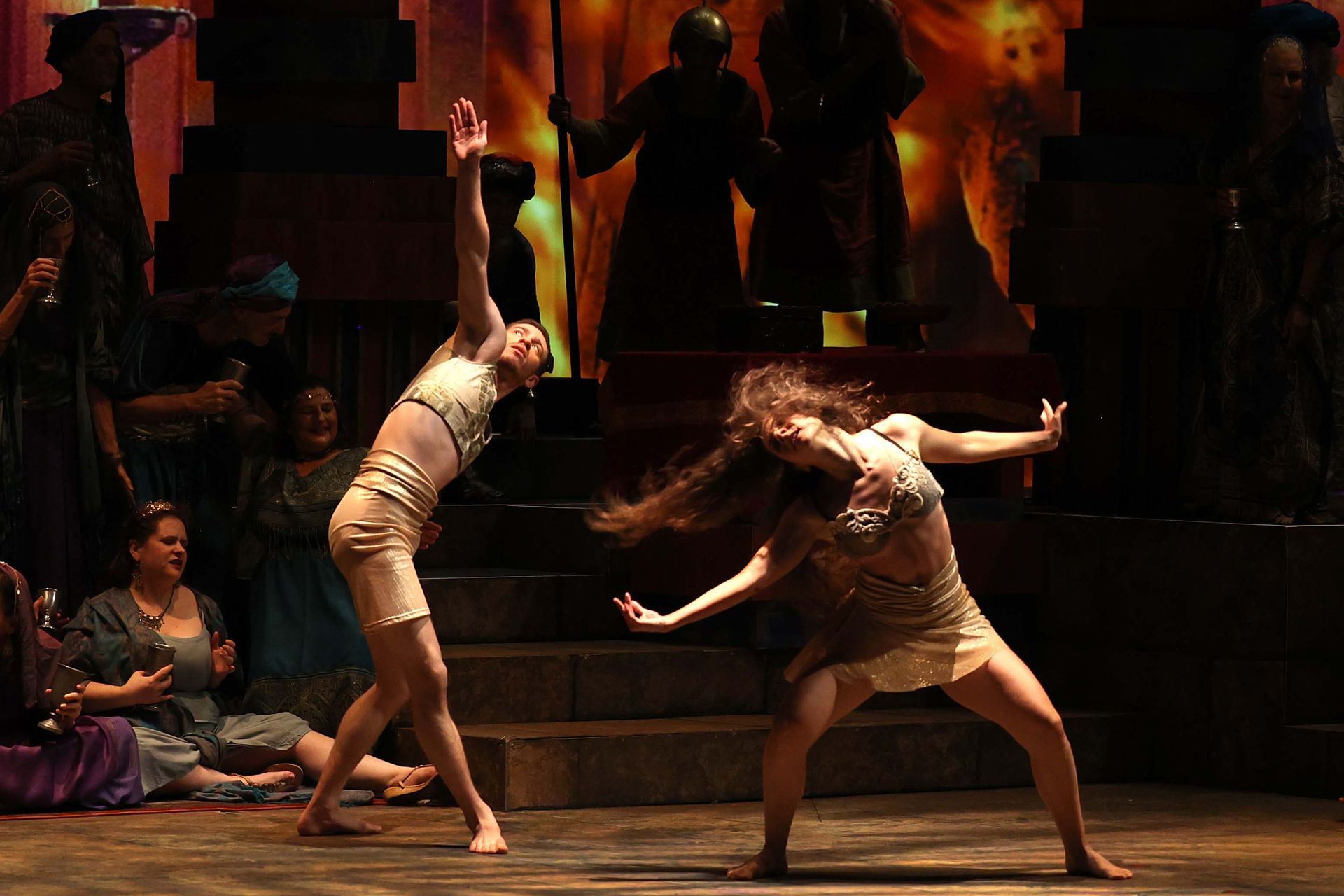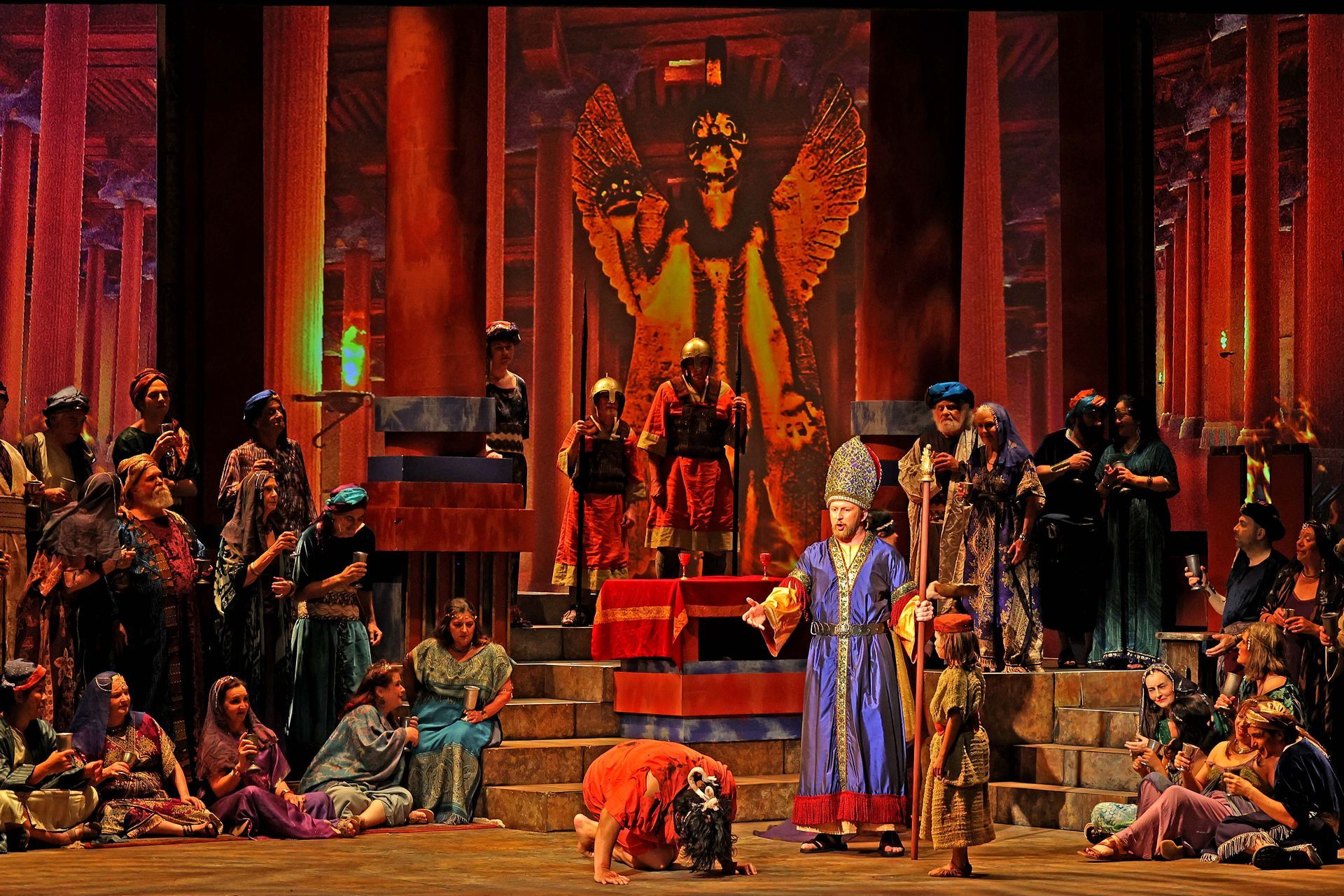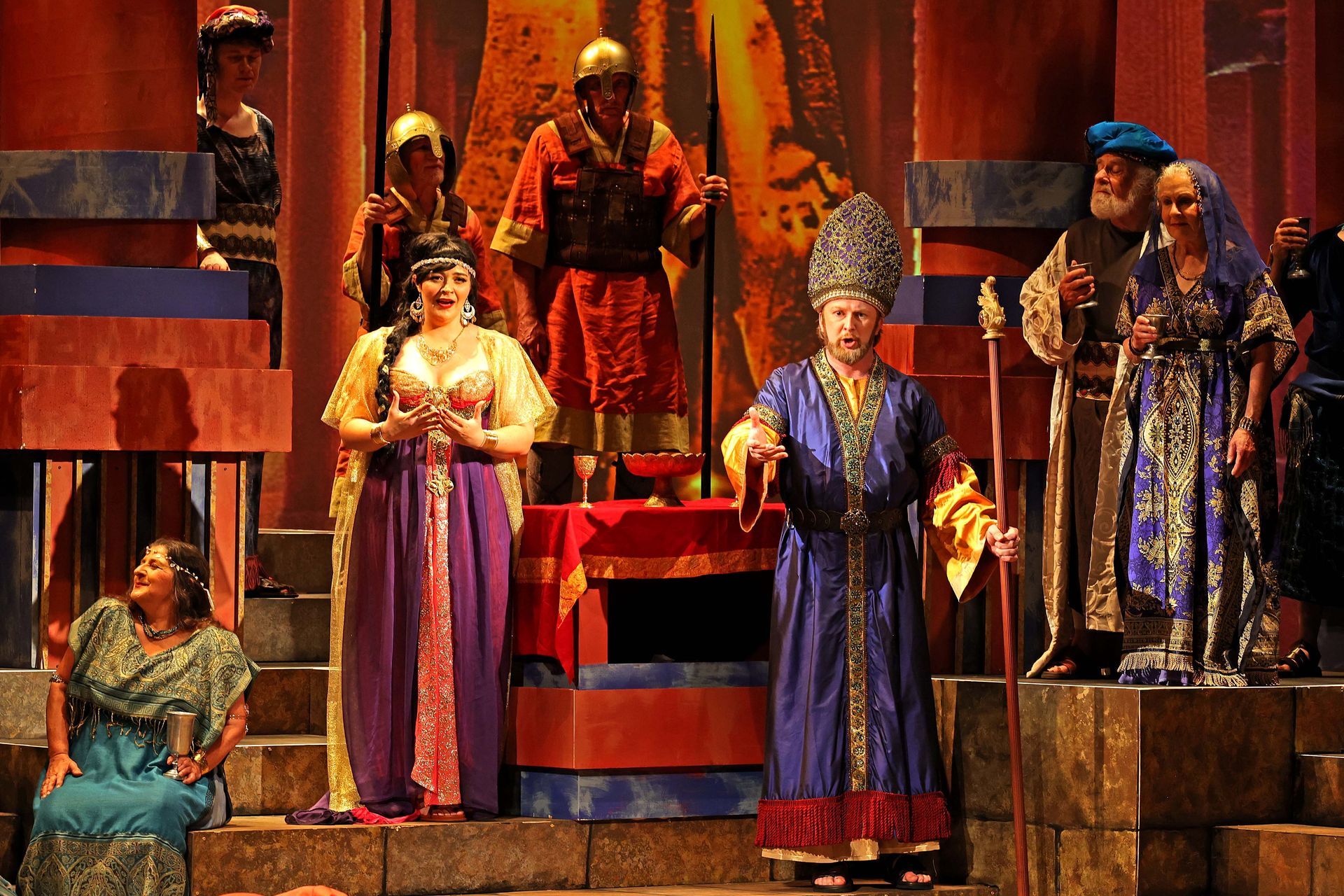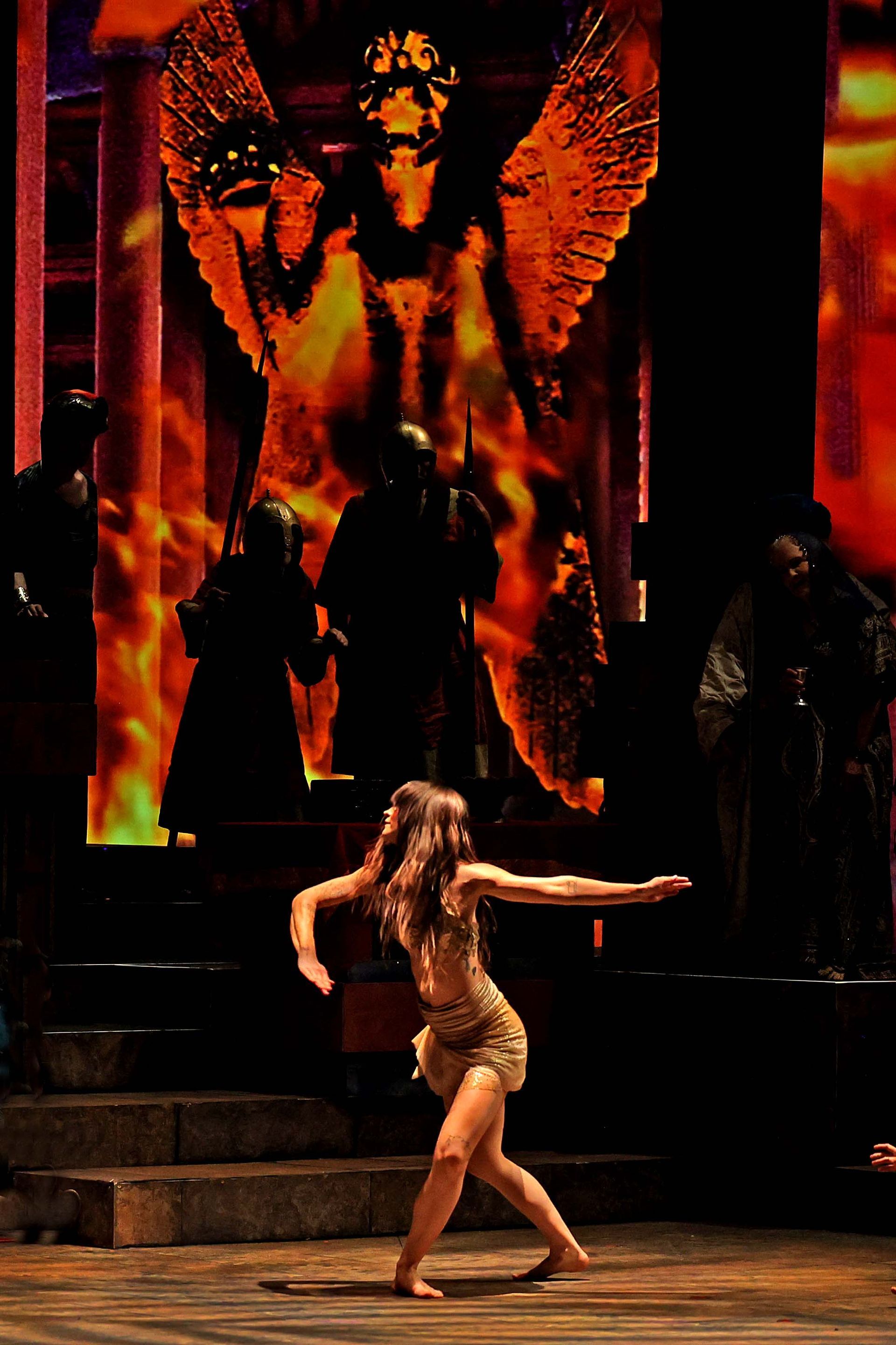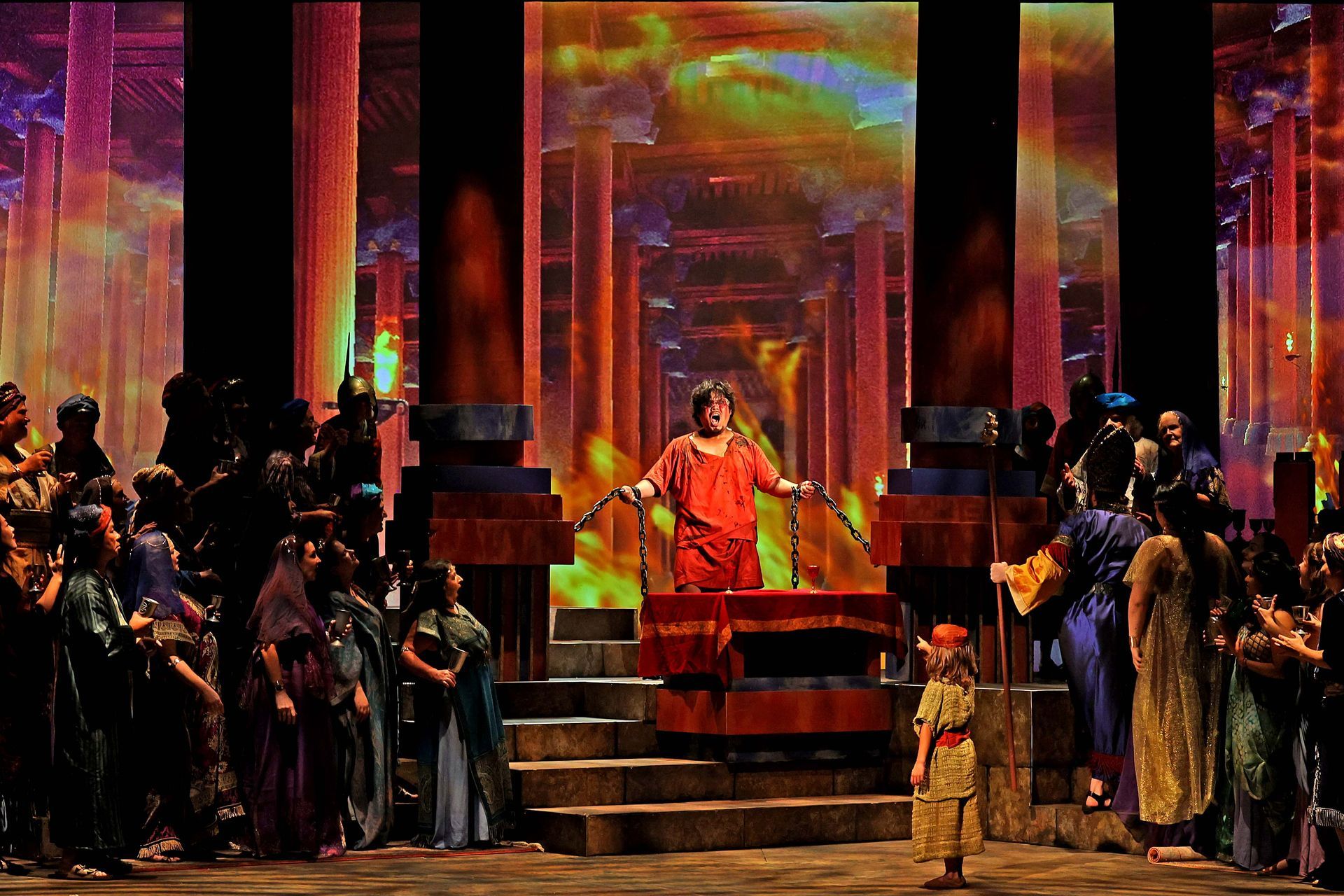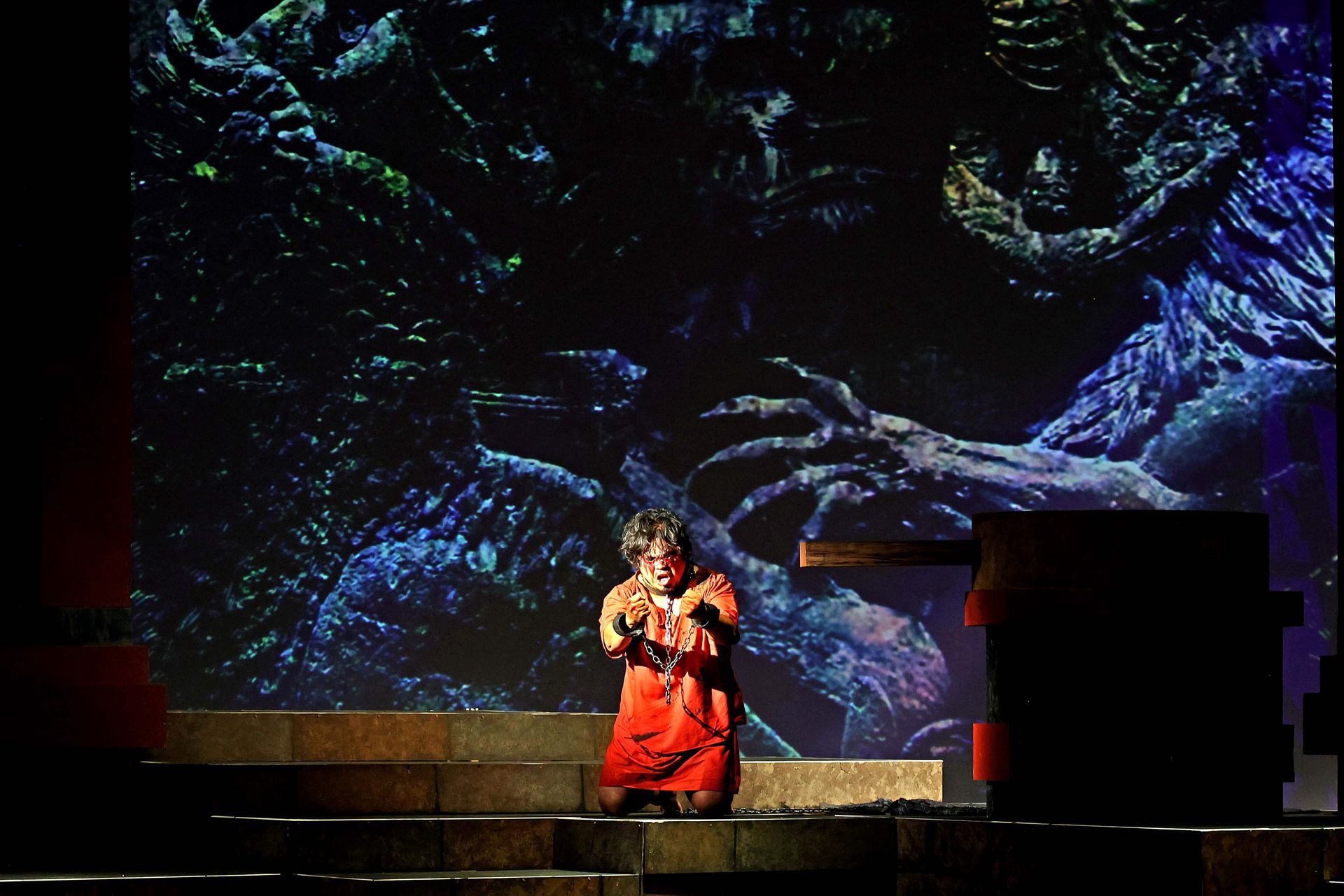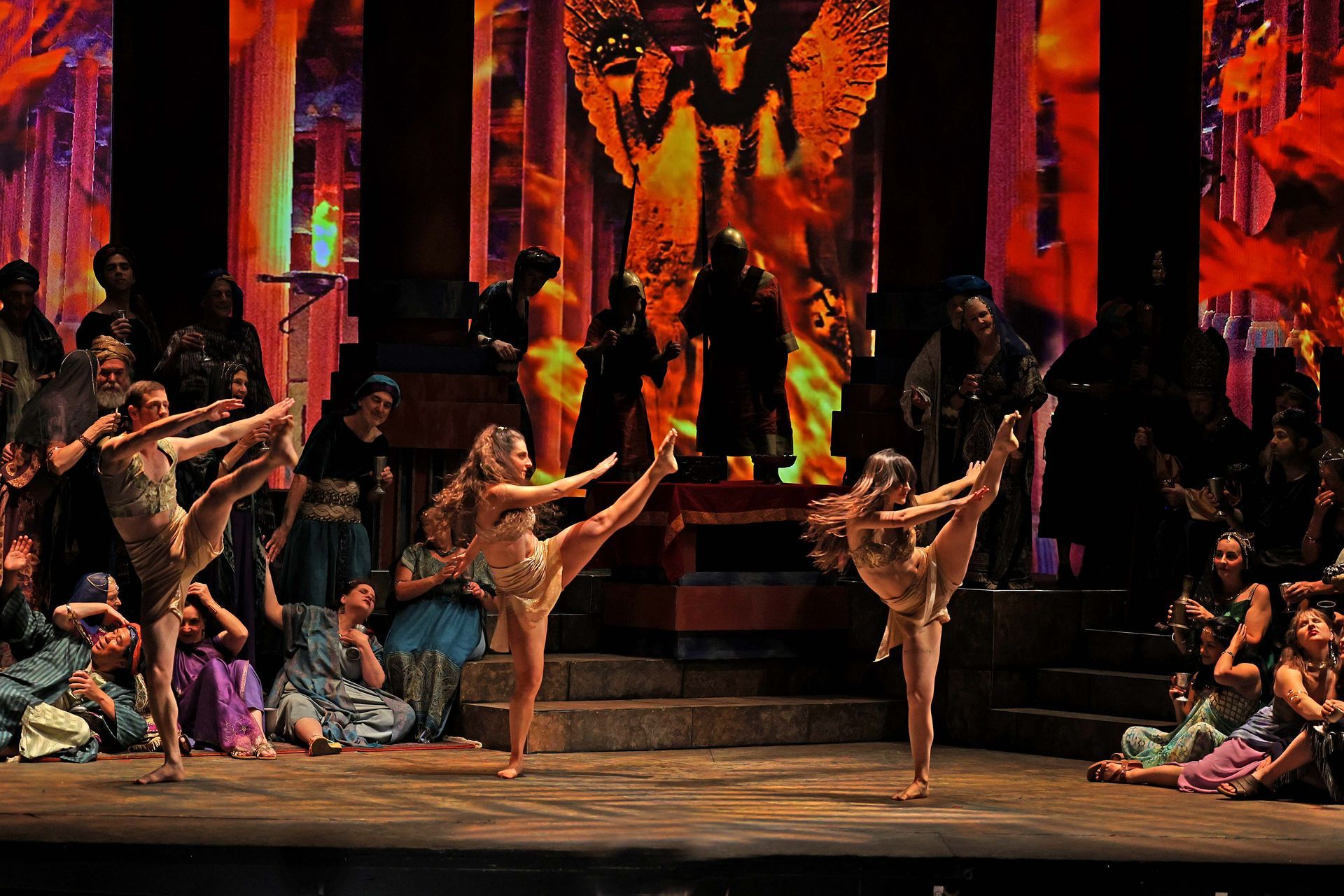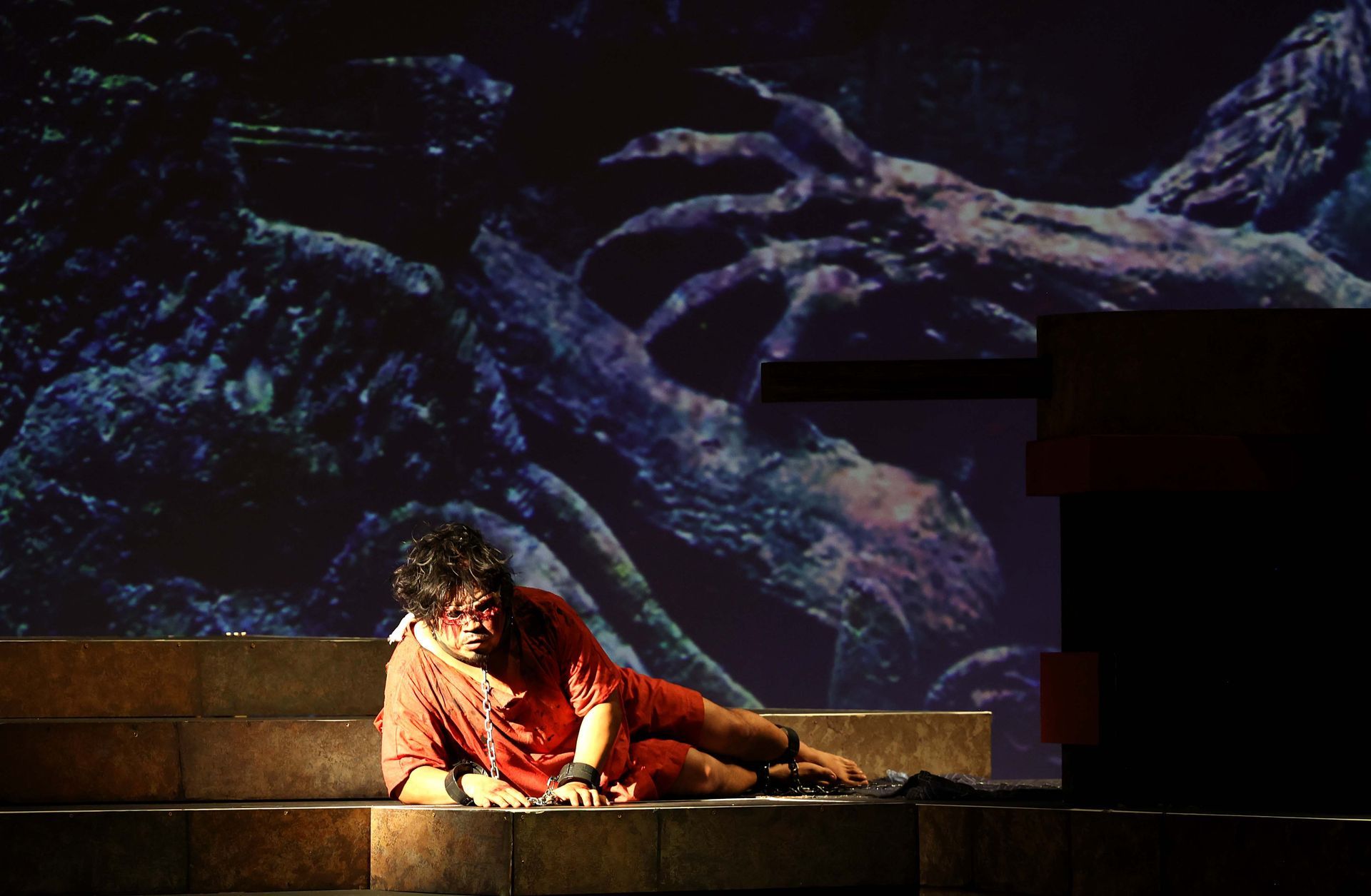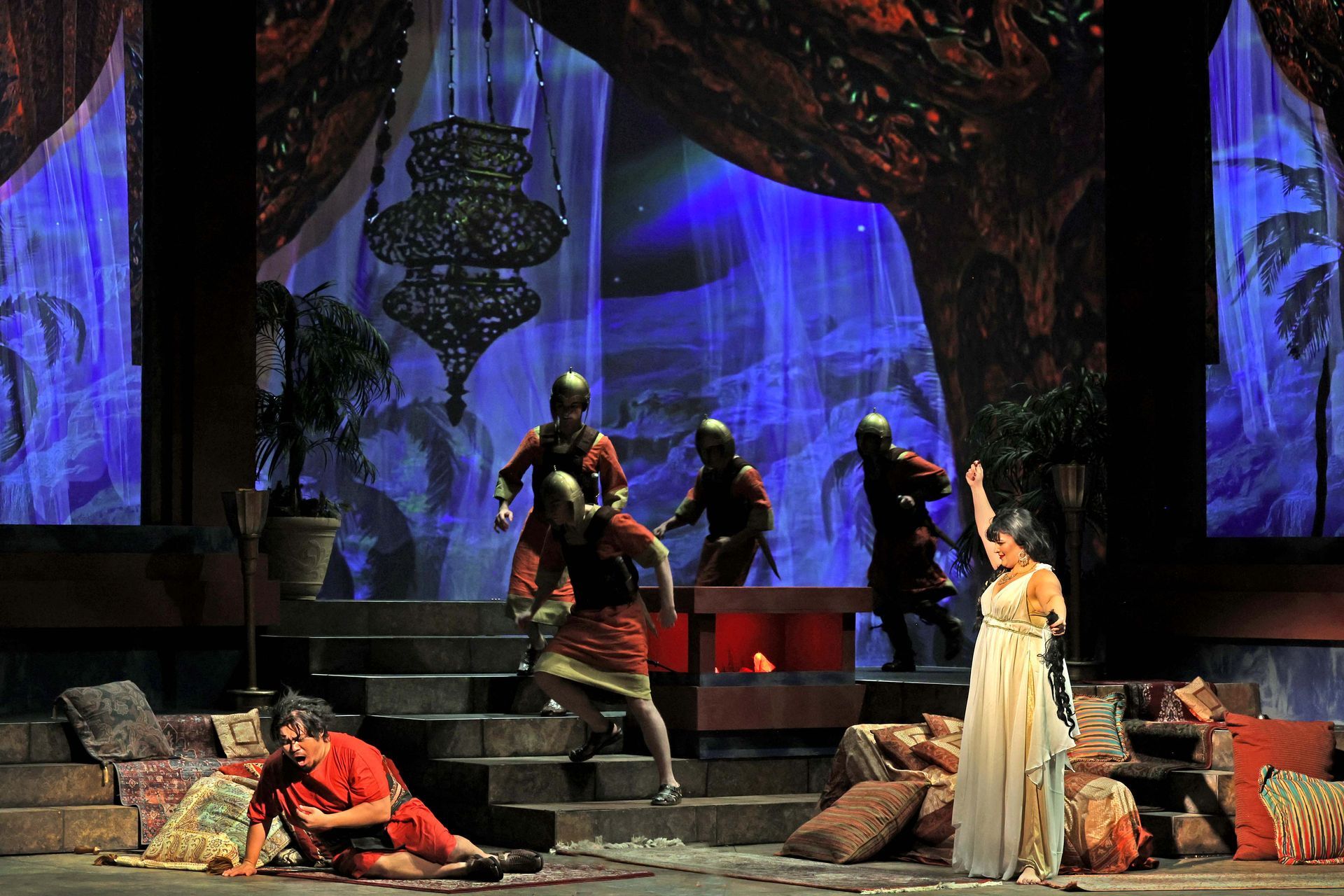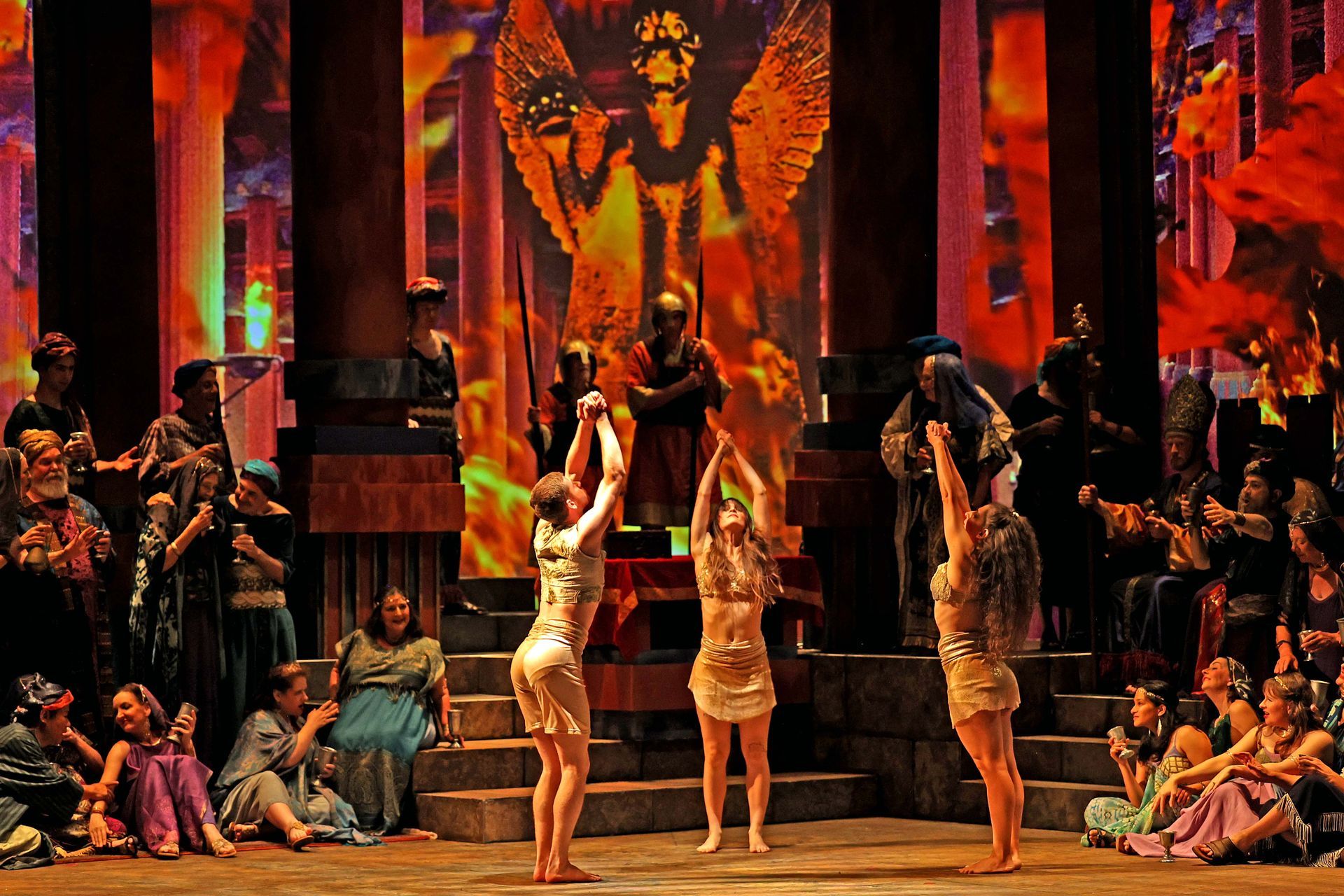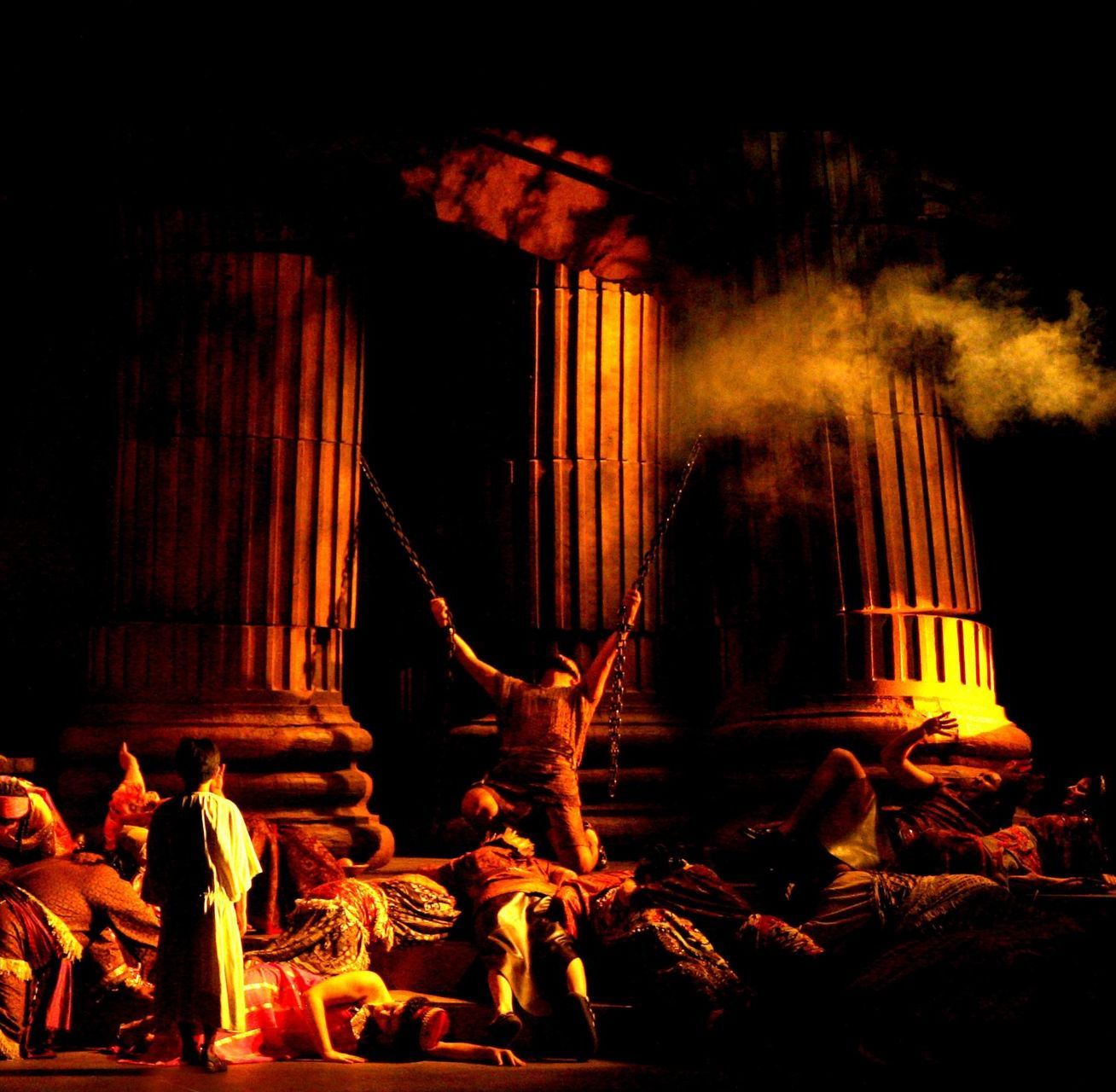
Samson et Dalila
Camille Saint-Saëns
Libretto by Ferdinand Lemaire
Opera in three acts
In French with English titles
Friday, Oct 10 - 7 p.m.
Sunday, Oct 12 - 2 p.m.
Saturday, Oct 18 - 7 p.m.
Sunday, Oct 19 - 2 p.m.
at the Lucie Stern Theatre
1305 Middlefield Rd., Palo Alto, CA 94301
Performances are 3 hrs long, including 2 intermissions.
FREE Preview with Piano
Thursday, Oct 2, 2025 - 7:00 p.m.
at the
Holt Building
221 Lambert Ave, Palo Alto, CA 94306
Samson et Dalila - 2025 - Media Gallery
PRODUCTION PHOTOS
About
Samson et Dalila
World Premiere: Grosshertzogliches Theater - Weimar
WBO Premiere: Oct 14, 2011
Pictured: Interior view of the Grosshertzogliches Theater in Weimar
Camille Saint-Saëns wanted to write an oratorio on a biblical topic. He approached a talented young writer, Ferdinand Lemaire, who was married to one of the cousins of Saint-Saëns' wife, to write the libretto. Lemaire convinced him that he should write an opera instead. The decision was fateful. Most opera houses refused to stage a biblical topic. Franz Liszt was impressed by the work and wanted to support the young composer, and he used his influence to get it staged in Weimar. The opera eventually became popular by the 1890's, entering the standard repertoire, and it was performed around the world. By the 1920's, the Paris opera alone had presented more than 500 performances of it.
Samson et Dalila is based on the story in Chapter 16 of the Book of Judges. The libretto skips over the initial characterization of Samson as a man of supernatural strength, dropping from the story the battles that resulted in Samson's fame, and focusing instead on Dalila, who is depicted as manipulative and bent on revenge.
The story is set in Ghaza in 1150 BC, and depicts the Jews as slaves of the Philistines. Guided by messianic visions, Samson leads a revolt during which he kills Prince Abimelech, and the Jewish slaves take control of the city. The Grand Priest of Dagon, the god of the Philistines, asks Dalila for help in discovering the source of Samson's supernatural strength. In the second act, in a powerfully dramatic scene in her tent, she seduces Samson and learns that the secret of his strength lies in his long hair. When he falls asleep, she cuts his hair and turns him over to the Philistine soldiers, who blind him and bring him in chains to the temple of Dagon, to be sacrificed. While a baccanal is in progress, he implores God to grant him a moment of his former streghth, and he dislodges the columns that support the temple, collapsing the roof over the Philistines.
Creative team
José Luis Moscovich - Conductor and Stage Director
Peter Crompton - Set and Projection Designer
Callie Floor - Costume Designer
Danielle Ferguson - Lighting Designer
Frederic O. Boulay - Projection Systems Designer
Daiane Lopes da Silva - Choreographer
David Gillam - Makeup and Wig Designer
Shirley Benson - Props Designer
Giselle Lee - Sound Designer
Pictured: Floorplan for a set design by Peter Crompton
Cast
Samson - John Kun Park
Dalila - Kim Stanish*
High Priest of Dagon - Kellen Schrimper*
Abimelech/Old Hebrew - Casey Germain
First Philistine - Anthony Castillon
Second Philistine - Daniel Morris
Messenger - Chris Hawkes
Dancers
Aikaterini Bousleli
Lydia Lathan
Tai Lum
Supernumeraries
Will Todd
Michael Pleban
Hayden Alexander Beattie
* First appearance with WBO
Photo: Otak Jump
Chorus
Bruce Olstad - Chorusmaster
Joanne Bogart - Chorus Manager
Dee Bailey, Mark Baushke, Didier Benoit, Joanne Bogart, Richard Bogart, Geordie Burdick, JoAnn Close, Cassidy Fink, Michael Good, Chris Hawks, Lynne Haynes-Tucker, Susan Hogben, Sofia Kenny, Patrick Kiessling, Jeffrey Lampert, Ning Leng, Stephen Miller, Joanne Newman, Lindarae Polaha, Philip Schwarz, Ashley Shannon, Jessica Shannon, Miles Spielberg, Jo Taubert,Terra Terwilliger, Tim Tsang, Kim Van Tran
Orchestra
Kristina Anderson (concertmaster)
Violin I · Emily Chiet, Kate Wahl, Sofia Fojas
Violin II · Andrew Lam, Lisa Zadek, Gulnar Spurlock, Julian R. Brown
Viola · Thomas Elliot, Donny Lobree, Mark Fish
Cello · Thomas Shoebotham, Daniela Gonzalez Siu
Bass · Christy Crews
Flute/Piccolo · Vivian Boudreau
Oboe/English Horn · Meave Cox
Clarinet - Arthur Austin, Stephen Zielinski
Bassoon · Amy Duxbury
Horn · Cathleen Torres, Diane Ryan
Trumpet · Richard Leder
Trombone · Curtis Azevedo
Timpani · Don Baker
Harp/Percussion · Gennaro Porcaro
~
Orchestra Librarian · Virginia Smedberg
Orchestra Manager · Christy Crews
* First appearance with West Bay Opera
Samson et Dalila - 2025 - Press and Reviews
Read the review by Victor Cordell
Samson et Dalila
Posted on October 14, 2025 by cordellreports
In the performance world, a title comprised of a man’s and a woman’s name is pretty reliably a love story, sometimes tragic – Romeo and Juliet, Abelard and Heloise, and so on. For those not versed in the Biblical saga of Samson from Judges, Chapter 16, they may expect “Samson and Delilah” might fall into that category. But rather, it is a grand deception. The Philistine seductress is motivated by hatred for the enemy Hebrew people and by revenge for what she wrongly believes is her paramour’s rejection and ridicule of her.
Today, we accept Biblical stories and personages on the stage as routine. But when the French opera, Camille Saint-Saёns’ Samson et Dalila, with libretto by Ferdinand Lemaire, premiered in 1877, such representations were typically banned from performance, especially in English speaking countries. Interest in the composer’s home country of France was so tepid that it opened in Germany. However, this masterpiece worked its way into the repertoire and has become an understandably beloved work.
Illustrative of French music of the late 19th century, Samson et Dalila has much to recommend it. Its lush orchestration and its stirring choruses are compelling. Arias and ensembles are melodic and important to the plot. Especially noteworthy is the trio in which the Old Hebrew warns Samson that love for Dalila would lead to tragedy. Saint-Saёns also adopted Wagnerian motifs. Most enchanting is the graceful fluttering, especially of the flute, that produces anticipation for the opera’s signature aria. And while the basic plot line is known to most opera goers, it is nonetheless dramatic in its consequences and its execution.
West Bay Opera’s production extracts all that can be expected from the opera by a company of its size, and that is considerable. As the first opera that General Director José Luis Moscovich ever saw, his enthusiasm and search for excellence in the piece come through in his spirited conducting, bobbing and weaving with exacting thrusts at the instruments as they deliver highlights in the score. The resulting sound is exemplary
Veteran of recent West Bay productions, John Kun Park as Samson brings a powerful tenor voice and presence to the role. He is imposing in his portrayal, first strutting and energetic as the potent leader of the Hebrew people enslaved by the Philistines and later subdued as the blinded and weakened shadow of his former self. Park’s particular strength is in revealing anguish in his singing and acting, whether depicting rage or submission. Despite his ability to achieve great passion and volume, however, his timbre is a little muffled, having less than exemplary clarity.
Dalila is among the more venomous, detestable title characters in all of opera. Yet this is one of the great mezzo-soprano roles. Although the gullible womanizer Samson is deluded into thinking that she loves him, betrayal and destruction motivates her from the start. Mezzo-soprano Kim Stanish is Dalila. She possesses the demanding vocal characteristics required for the role, which include a strong and complete mezzo range and the ability to sing with the extremes of sweetness or anger.
The aria “Amour! Viens aider ma faiblesse” (“Love! Overcome my weakness”) early in Act 2 tests the artist. Stanish conquers it with a delightful ascending run from her resonant chesty lows to her bright heady highs. If there is a vocal weakness, she doesn’t fare as well in competing with the orchestra at points in her mid-range. In terms of her portrayal, perhaps the wig, makeup, or costumery undermine her, but she doesn’t convey the grim resolve as convincingly as desired.
The signature aria in the opera is Dalila’s captivating, unforgettable “Mon coeur s’ouvre à ta voix” (“My heart opens at your voice”), which has even crossed over into other musical genres. Given its opening line, and as one of opera’s truly beautiful arias, most listeners would expect that it is a sincere love song, but it is really a hypocritical deception. Stanish gives a completely pleasing rendering of the aria, and when it turns into a beautifully harmonized asynchronous duet, Park joins in showing a mellifluous quality to his voice.
With the French market of the period in mind, the composer also inserted ballet, most significantly the Bacchanale, which contains the other most recognizable music from the opera. Unlike the remainder of the score, the exotic, heavily punctuated dance music is very Middle-Eastern. The writhing dance is well choreographed and performed. However, while the orgiastic theme and dance fits with the storyline, it comes at a strange time in the opera, just when the audience is looking for denouement and closure.
The overall production, stage directed by Maestro Moscovich, works nicely. West Bay has long been adept at making the stage seem larger than it is through tiering and projections, with credit as usual to Peter Crompton and Frédéric O. Boulay. Callie Floor’s extensive costumery also adds to the look of the production.
While the stage isn’t large enough to accommodate several columns from the temple physically collapsing at the conclusion, a combination of live action and graphics is used to depict the destruction. But for some reason, the simple act of the Philistines falling to the ground to demonstrate that Samson destroyed everyone in the temple does not occur. Notwithstanding these minor quibbles, the opera and this production are highly worthy and enjoyable.
Samson et Dalila, composed by Camille Saint-Saёns with libretto by Ferdinand Lemaire and based on the book of Judges Chapter 16 from the Bible, is produced by West Bay Opera and plays at Lucie Stern Theatre, 1305 Middlefield Road, Palo Alto, CA through October 19, 2025.
https://cordellreports.com/2025/10/14/samson-et-dalila/
Title or Question
Describe the item or answer the question so that site visitors who are interested get more information. You can emphasize this text with bullets, italics or bold, and add links.Title or Question
Describe the item or answer the question so that site visitors who are interested get more information. You can emphasize this text with bullets, italics or bold, and add links.
